Laundry seeks diverse workforce, stronger community ties
Industry works to recover after Hurricane Michael
CHICAGO — As the Florida Panhandle picks up the pieces in the wake of Hurricane Michael, businesses in the laundry/linen services industry worked to resume operations as well.
Mike Larson, regional manager for Alsco, says in the days following the storm, it couldn’t reach its Panama City Beach Service Center (one of the hardest hit areas) for assessment. The company’s Tallahassee center lost power temporarily, and its Albany Service Center in Georgia sustained some damage, but deliveries were being made.
JENSEN USA reports that its main facility in Panama City sustained some roof damage, and its parts and machine warehouse came through relatively unscathed.
B&C Technologies’ Panama City facility escaped with no damage and opened with a skeleton crew. In addition, the company reports that it set up machines and fire cabinets to assist firefighters with cleaning and drying turnout gear and set up a laundry on premise for other emergency workers, as well its employees. ALN
BY MATT POE, EDITOR
WOODS CROSS, Utah — Intermountain Healthcare is a Utah-based not-for-profit system of 23 hospitals, 170 clinics, a Medical Group with about 2,300 employed physicians and advanced practice clinicians, a health plans group called SelectHealth, and other medical services.
As can be imagined, such a large network creates a lot of laundry. Intermountain Healthcare’s Central Laundry is approaching 40 years as being the predominant commercial laundry service in Utah.
The laundry facility started operating in 1979, originally serving just five Intermountain hospitals at the time: included Cottonwood (now TOSH), LDS Hospital,

McKay-Dee, Primary Children’s Hospital, and Utah Valley Hospital.
Now, the 70,000-square-foot facility here has grown to become the largest healthcare laundry service in Utah and surrounding
states. The facility serves all the laundry needs for most Intermountain facilities, as well as many other medical clinic groups and

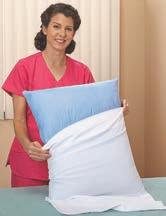

Textiles: What will be trending in 2019?
BY MATT POE, EDITOR
CHICAGO — There are many factors that laundry and linen services must take into account when looking at their business strategies.

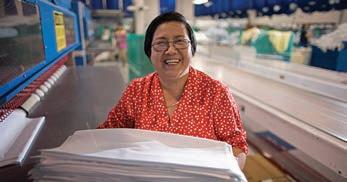
Textiles are at the top of the list. More specifically, what will impact the cost of textiles and how they are processed?
American Laundry News contacted several experts to get their insight into what will impact textiles in 2019.
“[The year] 2019 will prove to be an interesting, yet challenging, year for the textile industry, including laundry/linen service providers,” says Steve Kallenbach, director of market solutions for Los Angeles-based textile provider ADI American Dawn.
TARIFFS, TECHNOLOGY
The current trend of higher duties toward China-based imports will be at the forefront of textiles, depending on which textiles are impacted, Kallenbach says—especially as duties are projected to continue and increase.
He says that U.S.-based mills/distributors are already working on contingency plans to move imports from China to other, more tariff-friendly nations. That process will likely take more than a year to reposition in other countries. At that point, it will take a number of months for the supply chain to catch up.
“Be prepared for some interruption of core goods for 2019 business year,” he says.
One of the biggest market impacts will
Columnist at Large

In this issue, Eric Frederick shares his thoughts on the value of seeking advice.

Panel of Experts
Our experts offer their advice on how to protect a laundry facility against flooding.
NOVEMBER 2018 Late News
www.americanlaundrynews.com INSIDE [4] See INTERMOUNTAIN on Page 6
The Newspaper of Record for Laundry & Linen Management
See TEXTILES on Page 8
[16]
Costs, fabrics, processing … interesting things are afoot in textiles for the coming year
Utah’s largest commercial facility approaching 40 years in service
Intermountain Healthcare’s Central Laundry have had success with immigrant employees, like Hao Tran. (Photo: Intermountain Central Laundry)
Healthcare textiles, such as personnel uniforms and sheets, influence patient satisfaction.
Volume 44, Number 11 [24] PRODUCT SHOWCASE UNIFORMS & SERVICE APPAREL
(Photo: Encompass Group LLC)
California healthcare laundries gain flexibility
SACRAMENTO, Calif. — California Gov. Jerry Brown (D) signed legislation into law Sept. 20 that reforms California’s Title 22 code, which regulates the laundering of healthcare linen, reports TRSA, the association for linen, uniform and facility services.
The legislation, AB 2679, sponsored by Assemblymember Patrick O’Donnell (D-Long Beach), will give operators flexibility in processing healthcare linens to use lower wash temperatures and shorten the wash time.
Previously, the Title 22 code prescribed laundering healthcare linens in 160 F water for a minimum of 24 minutes. However, due to advances in chemical technology and improvements in the mechanical action of the laundry process, linens can be processed at a lower temperature and less time while still being safe.
TRSA played a key role in reforming the outdated Title 22 regulation. Its efforts included association members attending two California Legislative Conferences in Sacramento in order to urge lawmakers to support the bill.

The original version of AB 2679 simply required the California Department of Public Health (CDPH) to update the Title 22 regulation, allowing for flexibility in the laundering process by Jan. 1, 2020. However, throughout the legislative process, the bill was amended to a better outcome for laundry operators, shares TRSA.
Instead of waiting for the CDPH to rewrite the regulation, healthcare linen processing will be tied to the processing standards of the Healthcare Infection Control Practices
Advisory Committee (HICPAC), TRSA says. The flexibility to decrease temperature and time will occur much sooner.
“This bill is a great opportunity for the healthcare sector of the linen, uniform and facility services industry,” says Kevin Schwalb, TRSA’s vice president of government relations. “Operators will soon have flexibility in laundering healthcare linens. The final version allows for much quicker implementation of the flexibility than the original language.
More specifically, the new law would, on or before Jan. 1, 2020, require each general acute care hospital and acute psychiatric hospital, including those facilities that use a medical laundry service provider, to adopt and implement a linen laundry processing policy that is consistent and in accordance with the most recent infection control guidelines and standards developed by the federal Centers for Disease Control and Prevention (CDC) and the federal Centers for Medicare and Medicaid Services (CMS).
Publisher
Charles Thompson
Phone: 312-361-1680
E-Mail: cthompson@ ATMags.com
Associate Publisher/ National Sales Director


Donald Feinstein
Phone: 312-361-1682
E-Mail: dfeinstein@ ATMags.com
Editorial Director
Bruce Beggs
Phone: 312-361-1683
E-Mail: bbeggs@ ATMags.com
Editor Matt Poe
Phone: 866-942-5694
E-Mail: mpoe@ ATMags.com
Production Manager Roger Napiwocki
LANSING, Mich. — Cintas Corp., a supplier of corporate identity uniform programs, promotional products, restroom supplies, first aid, fire safety products and services, and industrial carpet and tile cleaning, hosted
a groundbreaking ceremony in September to mark construction of its new facility in Delta Township.
The new Cintas facility will be a 55,000-square-foot laundry operation that will add approximately
60 jobs in sales, skilled, technical and office operations. The company will begin hiring for positions in the fall of 2019.
“We are thrilled to deepen our relationship with Delta Township by expanding our facilities in the area,” says Tom Boik, general manager of Cintas in Lansing. “This new facility will not only bring new jobs to the area, but it will also help us better serve a growing variety of customers in central Michigan.”
Headquartered in Cincinnati, Cintas has been a part of the
ALN
“Jan. 1, 2020, is the deadline for developing new laundering policies,” Schwalb says. “The sooner facilities can adopt new policies, the sooner operators will have flexibility in processing linens. This would not have occurred if it was not for those individuals that took time out of their schedules to attend the California Legislative Conference to tell the industry’s story.”
Digital
Media Director
Nathan Frerichs
Phone: 312-361-1681
E-Mail: nfrerichs@ ATMags.com
Advisory Board
David Barbe • Jim Buik
Tony Jackson • Janice Larson Tom Marks
Main Phone: 312-361-1700 Fax: 312-361-1685
Subscriptions
630-739-0900 x100 www.americanlaundrynews.com
Lansing community for more than 20 years and operates five plants and six branches throughout Michigan. Located at the center of the state, the new location will help Cintas better serve its vast customer base.
“Cintas is a nationally recognized company, and we are thrilled that they have decided to continue to expand in Delta Township,” said Kenneth R. Fletcher, Delta Township Supervisor. “We look forward to supporting Cintas as they continue to grow.” ALN
ARCO/Murray completes new plant for Alsco
KYLE, Texas — ARCO/Murray recently completed construction of a 96,000-square-foot, build-to-suit laundry facility for linen and uniform rental company Alsco here, the national construction company reports. This is Alsco’s largest new plant in the United States and its first ground-up project since 2014.
The facility includes a new 9,000-square-foot office, 6,500-squarefoot mechanical room and a 9,000-square-foot second-level mezzanine. The exterior walls are concrete tilt construction with an interior clear height of 28 inches.
ARCO/Murray says the equipment was provided by a mix of vendors, including washroom equipment by Milnor and Ellis; rail by Ryco and Kannegiesser ETECH; soil counting by Automation Dynamics; finishing equipment from JENSEN, Leonard Automatics and Tingue Brown; and dryers from Ellis. Ludell and Norchem supplied the mechanical room equipment.
The project was completed and turned over to Alsco 10 days ahead of the contracted completion date. ARCO/Murray’s Justin Hearld was the project manager with David Rogers serving as the superintendent.
American Laundry News (ISSN 1091-9201) is published monthly. Subscription prices, payment in advance: U.S. 1 year $46.00; 2 years $92.00. Foreign, 1 year $109.00; 2 years $218.00. Single copies: U.S. $9.00; Foreign $18.00.
Published by American Trade Magazines LLC, 650 West Lake Street, Suite 320, Chicago, IL 60661. Periodicals postage paid at Chicago, IL, and at additional mailing offices.
POSTMASTER, Send changes of address and form 3579 to American Laundry News Subscription Dept., 440 Quadrangle Drive, Suite E, Bolingbrook, IL 60440. Volume 44, number 11. Editorial, executive and advertising offices are at 650 West Lake Street, Suite 320, Chicago, IL 60661. Charles Thompson, President and Publisher. American Laundry News is distributed selectively to qualified laundry and linen management and distributors in the United States.
© Copyright AMERICAN TRADE MAGAZINES LLC, 2018. Printed in U.S.A. No part of this publication may be transmitted or reproduced in any form, electronic or mechanical, without written permission from the publisher or his representative. American Laundry News does not endorse, recommend or guarantee any article, product, service or information found within.
Opinions expressed are those of the writers and do not necessarily reflect the views of American Laundry News or its staff. While precautions have been taken to ensure the accuracy of the magazine’s contents at time of publication, neither the editors, publishers nor its agents can accept responsibility for damages or injury which may arise therefrom.
MEMBERSHIPS
2 NOVEMBER 2018 | AMERICAN LAUNDRY NEWS www.AmericanLaundryNews.com
signs
to ease wash temperatures, time;
to
New 55,000-square-foot laundry operation to add 60 jobs, hiring begins in fall 2019
Gov. Jerry Brown
legislation
TRSA key
effort
INSIDE: November 2018 • Vol. 44 | No. 11 [10] Reinventing Quality Linen Services Find out how laundry/linen service owner has expanded, streamlined and improved plant for hefty gains [12] Examining Tunnel Washer Flexibility Today Tunnel washers have made leaps forward in technology, production capabilities in the past 10 years [14] Community Partnerships for Hiring Help In this month’s OPL 101, read how White River Health System’s laundry partnered with a local ministry [20] Ironing Fundamentals Lead to Smooth Goods A recent ALM webinar covered the fundamentals of ironing for good quality finishing results [26] Classified Advertising [27] Source Directory [30] Trade Ticker Cintas Corp. to construct new
(Image licensed by Ingram Publishing)
facility in Michigan
ALN
Our M-Series Washer-Extractors are built for optimum performance and easy service access. The simple design with single pivot two-way tilt and large door provide safe, fast and efficient loading and unloading. The open access allows for easy and simplified maintenance. Milnor’s unique and innovative SmoothCoil™ Suspension System means maintenance-free, superior vibration dampening with less wear and tear. Our intelligent bearing design provides three water seals and an excluder seal mounted on an easy-to-replace seal sleeve, along with a leak-off cavity to keep water and chemistry away from bearings. All of this and more, built to Milnor’s legendary ruggedness and durability.

Contact an authorized Milnor distributor or call 504-712-7656 to find out more.
www.milnor.com

“When I saw an overhead sling automatically loading walk-off mats directly into a Milnor 450 lb open-pocket washer-extractor, I was sold!”
– Randy Clemens, General Manager of Clemens Uniform
Need laundry employees?
It’s no secret that labor is a struggle for many laundry/linen service operations.
It’s a struggle in most businesses today, to be honest.
Low unemployment, the push for higher wages, inexperienced, unskilled workers—it’s a challenge, as they used to say, “to find good help these days.”
That’s why I found it interesting to learn about the two laundry operations highlighted in this issue of American Laundry News Intermountain Healthcare Central Laundry in Woods Cross, Utah, and Quality Linen Services in Salisbury, Md.
While both facilities have taken steps in terms of equipment and chemistry to increase efficiency, both have also made concerted efforts to embrace diverse work forces.
Intermountain’s Central
The Editor’s Desk
MATT POE
Laundry looks at its hiring practices as reflecting the demographics of the area, helping to create understanding. Starting on page 1, read about how the laundry has integrated people with disabilities, along with immigrants and refugees, into its workforce.
Quality Linen Services owner Dicky Smith is legally deaf, need-


ing a cochlear implant to hear, so he, too, makes the effort to reach out to folks with disabilities. He also makes sure his employees are paid well so that he always has staff (page 10).
White River Health System’s laundry has also been using a unique way to fill positions on the washroom floor—a community partnership.
Where Central Laundry and Quality Linen Services seek out disabled and immigrant employees, White River Health System has partnered with a local ministry in Batesville, Ark., to help men dealing with drug and alcohol addiction. You can read the full OPL 101 on page 14 by George Latus.
Of course, this issue has much more in its pages, from tunnel washers (12) to ironing fundamentals (20) to help keep it clean, everybody. ALN

Industry sound on injury/illness record keeping?
I found the information and results from the safety survey (October 2018, page 2) interesting, as it is showing very positive results.
However, I believe the textile rental industry should be a bit skeptical about the validity of the results. In a quick review of the BLS statistics from 2012 to 2016, there is a marked increase in the OSHA total injury and illness rate for the industry.
Over my 15-plus years as a safety professional dedicated to the textile rental industry, I’ve found that, in general, the industry is not as familiar with the OSHA record-keeping standard as it needs to be. Recently, I reviewed OSHA records from multiple linen plants and found numerous errors in record keeping.
Some of these were simply failing to count the “days away” accurately, often not accounting for weekends and holidays, while others neglected to stop counting when the injured employee reached the maximum number of days.
Other errors included improperly classifying a case or failure to classify at all. Each of these exam-

ples represent failures to comply with the recordkeeping standard.
Changes in OSHA record keeping in 2002 required that textile rental companies begin recording injuries and illnesses. This represented a significant change. Prior to 2002, textile companies were exempt from record keeping.
Since that time, most companies have attempted to comply; however, there has been little direction or assistance. Employers are reluctant to reach out to local OSHA consultation offices, which are very willing to assist or at least point an employer in the right direction to get information.
Textile rental operators would be wise to ensure that those persons who are responsible for keeping OSHA 300, OSHA 301 and OSHA 300(a) summary are trained to understand the record-keeping standard to avoid errors, violations and citations.
Don Bock, CSP, ARM Seabright Safety Solutions Santa Maria, Calif.
RLLD
The need for advice is always there
I have been writing articles for this publication for many years. It has been an undertaking that I really enjoy.
One of the special benefits of my column is that occasionally I get a phone call or e-mail from a reader asking about how my recent article might apply to their current situation. I enjoy talking to them and helping them with their current challenge. To me, this is paying it back to all the many people who helped me during my first 10 years in the business.
Developing what I call an “educated phone book” is essential if you plan on making this industry your career.
I can remember attending the American Laundry and Linen College for the first part two and part three sessions. We all knew we were helping develop something really great. During my attendance, I added many key phone numbers to my phone book.
The first key number I added was that of Bill Webb. He was an expert of fixing laundry machinery. His depth of knowledge simply blew me away. I frequently called him with maintenance and repair questions. He was always willing to give me good, solid advice.
I met a number of excellent textile management and textile procurement experts, like Barb Williams. The more I learned, the more experts I added. I worked hard to learn as much as I could, but it was great to have people with more experience than me whom I could call on and see if they had ever run into the problem I was currently facing.
I have faced boiler problems, air compressor problems, staining problems, productivity problems, contract problems and textile failures, such as excessive shrinking on blankets or contour sheets. The challenges were never the same, and the need for advice was always there.
Recently, I was approached by one of my readers who asked if I would be willing to help them out. This person wanted me to review their marketing material, some of their proposals and be available to give them advice as they bid for additional business. So far, it seems to be a great situation for both of us.
The value of seasoned advice can help the relative newcomer from making serious blunders. It can help them improve their operations and become a success. Too often I have seen managers feel that by asking questions they are admitting they don’t know enough to do the job. This, of course, is not the truth.
After 43 years in the business, I was still learning every day on the job. Advanced equipment, chemicals and textiles presented new and challenging situations that had to be solved. If I could learn from someone else’s experience and find a way to apply it to my situation, then I was doing my job.
My boss did not expect me to have an immediate answer to every question, but he did count on me to do the research and find the answer. Having an educated phone book makes this process much easier. Making contact with well-established professionals and adding them to your resource list will pay benefits for many years to come.
Eric Frederick served 44 years in laundry management before retiring and remains active in the industry as a laundry operations consultant. You can contact him by e-mail at elfrederick@cox.net, or by phone at 540-520-6288.
4 NOVEMBER 2018 | AMERICAN LAUNDRY NEWS www.AmericanLaundryNews.com
From
COLUMNIST AT LARGE Eric L. Frederick,
ALN
Top Stories Appearing on AmericanLaundryNews.com for the 30 Days Ending October 15 (WE) = WEB EXCLUSIVE NEWS • California Healthcare Laundries Gain Flexibility • Behind-the-scenes Tour Launches New Washer • Leonard Automatics Appoints Watson President/CFO • Journal Publishes LCA on Reusable Isolation Gowns • Encompass Group VP Honored by Dept. of Veterans Affairs COLUMNISTS/FEATURES
Eric Frederick: Linen from the Patient Perspective • New Equipment Makes Impact on Campus
Remanufactured Decision Making (WE)
Laundry Has Good Family ‘Division’ • Q&A: Remanufactured Equipment Programs OUR SISTER WEBSITES From AmericanDrycleaner.com: • Machine Mania • We Are the Fixers From AmericanCoinOp.com: • Maytag Commercial Laundry Ready to Meet Multi-Load ...
Profiling Women in Laundry: Vivi Bueno
•
•
•
•
“I WORKED H A RD T O LEARN A S MUCH A S I COU L D, BU T IT W A S GRE AT T O H AVE P EOPL E WI T H MORE EX PERIENCE THA N ME WHOM I COU L D C ALL ON A ND SEE IF T HEY H A D EVER RUN IN TO T HE P ROB L EM I W A S CURRENTL Y F A CING.”
Letter to the Editor




















americandawn.com | imagine@americandawn.com HACCP IS ABOUT FOOD SAFETY In food processing plants, HACCP plans are about ensuring that critical control points are can open the door to this growing marketplace. CALL US: 800 821 2221 LET’S KEEP OUR FOOD SAFE
Intermountain
hospitals in Utah.
Last year, the Central Laundry processed more than 20 million pounds of laundry. One day alone, the facility processes 36 tons of laundry—the equivalent of an average family’s laundry done over the course of 40 years.
While it would be easy for management at the Central Laundry to focus on the amount of linens being processed, leadership has made a point to focus on the diversity of the surrounding community, being a part of it, hiring employees with disabilities and those coming from other countries.



“I think that our demographics are changing, and I think there is a natural progression toward more diverse workplaces and trying to understand how we can work with one another even though we have those differences,” says Richard Bott, laundry services director at Intermountain’s Central Laundry.
“Also, how can we enhance all the experiences we have because of the different backgrounds we come from? I think that’s a real positive if chosen to look at it that way.”
ENGAGED, ENABLED
Central Laundry has a sponsored work program with The Columbus Community Center in Salt Lake City to help people with disabilities gain vital work skills.
Bott shares that Columbus Community Center believes there is dignity through work. The center takes people who would normally be in day programs or different activities that don’t really have them engaged in society or in the community and puts them in a position to engage and grow.
“This kind of flips that, puts them out in the workplace, gives them opportunities to gain work skills so that they can be more engaged and live more meaningful lives,” he says. “We’ve had many successes over the years, and a lot have come through this program and now are full-time Intermountain employees.”
Sarah Willhard, who has a disability, has worked for Central Laundry for 12 years and is one of their most productive employees.
“It has been able to improve my work skills,” she says. Bott says that other participants in the program gained
worked skills and are now working for other employers throughout the community.
“I was a little nervous when we brought the folks from Columbus, didn’t quite know how they would mesh with our employees, but there’s tremendous coaching and camaraderie that I wouldn’t change our culture for anything,” shares Bott. “It’s a beautiful thing to see our folks help people with disabilities, and become their friends, and help them to become the best that they can be, so it’s actually transformed our environment for the good.”
He encourages anyone curious about how Intermountain’s workforce model has achieved success to come and visit the facility.
“I think there are a lot of people who are concerned about what folks with disabilities might mean, challenges,” explains Bott. “It sounds good, sounds positive, but a lot of people don’t see it working in their environment.”
BEACON OF HOPE
The laundry facility also employs immigrants from across the globe. More than two dozen different languages are spoken in the laundry, with many inspiring stories from the employees.
The Vuong family are refugees from Vietnam and endured hard trials just to make it to Utah. The Central Laundry has provided a stable job and became a beacon of hope for them.

Minh “David” Vuong spent 13 months in refugee camps after being tortured as a political prisoner in his home country of Vietnam. Now, after working at Central Laundry for more than 15 years, he gets emotional as he talks about how the job has helped his family.
“I appreciate what they have done for me,” Vuong says.
Lubjo Rajcevic came from war-torn Croatia in 1999. He spoke little English, but one day when he noticed one of the laundry machines was broken, he said, “I fix.” After that day, he has become one of the top maintenance workers.
Maintenance workers like Rajcevic are key to the laundry’s success, since the system is highly automated, ensuring correct processes per fabric type while reducing its chemical footprint.
Before 2002, the Central Laundry used 4 gallons of water per pound of laundry washed. After upgrading the systems, it now uses 0.6 gallons per pound.
The Central Laundry also has worked to keep costs in check even with the new automation. Compared to costs in 1990, the laundry’s costs are only half a cent more per pound of laundry cleaned.
Bott says Intermountain Central Laundry works with organizations like Utah’s Department of Workforce Services and LDS Family Services to create a “pipeline” for people immigrating to the United States to help them gain employment, help them and their families get established and help them understand the things that they need to do, such as create bank accounts to have direct deposits. They also help people understand insurance and other programs as they’re trying to make the transition to the United States.
He adds that Intermountain has had success with people simply immigrating here from other countries and refugees
that have come from different conflicts around the world.
“It ends up being a pretty good relationship all the way around because they come and they find a good employer that’s going to help them with the things that they need to get set up,” shares Bott. “Also, there’s not a high need for the work that we’re having them do to have them have a mastery of the English language. So, they can learn and grow as they continue to progress toward being citizens, and it ends up being just a good relationship.”
He says that many immigrant employees have served from 10 to 20 years, or more, at Intermountain, and the community sees it as a positive.
COMMUNITY SERVICE
The Central Laundry has also been dedicated to being an asset in the area, helping communities throughout Utah. This includes no-cost laundry services for the Ronald McDonald House and the Annual Rotary Club Coat Drive.
Bott believes Intermountain Central Laundry’s diverse workforce also helps the healthcare provider better serve the community.
“As our community is becoming more diverse, some of the things that maybe in the past we kind of thought we understood, we really don’t,” he explains. “So, I think it gives us a better look into where the community’s going, how the diversity numbers are changing and what we can do as a healthcare company to meet the needs. I think that’s a tremendous opportunity for Intermountain.”
There are also many things that Intermountain as a whole does to support the community with different donations and activities and support, according to Bott.
“There’s a big push to get ahead of causes of gaps in healthcare,” he says. “We’re looking to do things that are going to help keep costs low, helping people to get access is something they’re passionate about. We want people to get healthcare when they need it, to take care of things preventatively before there’s big cost for something that’s already on its way to being a full-blown health crisis.”
Intermountain and its Central Laundry have both grown over the years. They’ve grown with the community to serve it, and they’ve grown with diverse employment—a model operation for healthcare and laundry operations.
“One thing I think would be good is for folks who are curious is to come and witness it,” Bott says. “They should experience it so they can have an easier time how it might work in their situation.”
6 NOVEMBER 2018 | AMERICAN LAUNDRY NEWS www.AmericanLaundryNews.com
ALN
Lilijana Vucek checks stacks of hand towels in the laundry. (Photos: Intermountain Central Laundry)
Many employees, like Chung I Thu, have remained with Central Laundry for decades.
Muoi Ha preps folded sheets for an Intermountain facility.
Robert Medley (left) and Chung I Thu inspect gowns and scrubs in the Central Laundry.
Continued from Page 1












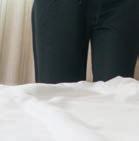












































INDUSTRIAL girbauindustrial.com INNOVATIVE LAUNDRY SOLUTIONS PROVIDING LAUNDRY SOLUTIONS GLOBALLY SINCE 1960 Whether you produce 20lbs of laundry per hour or enough to justify a tunnel washer, Girbau Industrial has a solution to wash, dry, iron, fold & stack. From pony washers and dryers to continuous batch tunnel systems and finishing equipment, we are your single source for it all.
likely be in healthcare, according to Kallenbach, as a lot of U.S. gowns and scrubs are currently made in China.
“We do expect the biggest growth to be in the healthcare markets, as more OPLs and co-ops move toward outsourcing to our industry,” he says. “This U.S. economy continues to be bright, and healthcare continues to expand, especially in the non-acute and sub-acute segments.”
Additionally, he sees more growth in microfiber cleaning products, as healthcare organizations continue to try to ward off hospital-acquired infections (HAI), and the responsibility (per government mandate) to pay for that medical fix, if it happens.
Kallenbach says uniforms and image apparel are always a good bet, as they have expanded for decades. In non-image uniforms, the hazard analysis and critical control points (HACCP) market (food safety) is growing by leaps and bounds. All cover apparel (lab coats, frocks, wraps) are continuing to grow in the uniform market.
Finally, he says that there will always be new fabrics introduced, which have to be proven to industrially launderable (IL).
“At present, our industry is focused on 100% spun polyester—especially in cover garments,” Kallenbach says. “We see many new primary garment fabrics and colors being used in the market, but ADI doesn’t make many primary garments, and can’t speak to that specific garment area.”
Lenore Law, owner of California Textiles, a source of linens, towels, sheets and more, also sees textile changes coming as a result of the tariffs levied by the administration this year.
“I’m seeing companies are very open to pay a bit more now for USA-manufactured product when the company offers a better quality,” she says.
Law goes on to say that companies care about the countries who
trade with textile suppliers, and so a blend of import and domestic works very well in today’s market.
“Some of the products that were made in China are now being finished in Vietnam on the napery and apron market, and a few other markets, which eliminates the tariffs on those products,” she shares. “Cotton prices per pound are stabilizing, which is a good sign for stabilized pricing as well.”
According to Law, one of the best markets the industry had was from 1997-2001, when the industry bought both domestic and import product for a blended and competitive product, both in quality and price.
“I feel we can all look forward to a growing economy with quality choices for 2019,” she adds.
Sami Kahen of Royal Blue International, an importer and domestic manufacturer of institutional linen items in Los Angeles, says that one of the largest forces on textiles is cotton and whether there is a good cotton crop from year to year which drives the price of textiles up or down significantly.
“Of course, the tariffs that are being imposed by the trade war with China may also indirectly affect textiles, but luckily thus far there has not been a direct affect because the tariffs are on rolled goods and not on finished goods such as bed sheets or pillow cases,” he says. “But no one knows what the future will hold.”
Hal Kanefsky, president and CEO of Monarch Brands, a wholesaler and manufacturer of microfiber, commercial linen, institutional towels, and wiper rags based in Philadelphia, doesn’t see much change in the textile industry in 2019 for the mills and customers he works with.
However, he does see some trends in microfiber, such as microfiber resort towels that dry quickly, don’t trap sand and dirt like terry towels, and that are light and thin, so more towels fit on trucks and in hampers. He adds that high-definition custom printing helps prevent linen loss and provides branded personality.
“[Custom printing] will not fade at the same rate as cotton but must be dried at low temperatures to
preserve the best qualities of the towels,” Kanefsky points out.
Timothy Voit, chief marketing officer for Thomaston Mills, says his company sees a move toward cotton and cotton-rich products in sheets and towels. While synthetic fibers such as microfiber promise lower energy bills, issues such as micro-plastic pollution are becoming much more public.

“Hotels and laundries would be wise not to get caught on the wrong end of an increasing legislative and P.R. push to address the water and food chain pollution caused by these products,” he says. “Additionally, many of these sheets, including modal (rayon) cause great difficulties for laundries, such as pilling and high shrinkage due to low heat settings.”
Voit says that Thomaston also
believes the tariff situation with China will not be resolved in the near term. While linens and uniforms have not been hit by tariffs yet, it is likely they will be hit with tariffs in 2019, as chemicals and machinery have been this year. These will prompt changes in many supply chains in the industry, as well as cost pressures.
HOSPITALITY, HEALTHCARE
“In hospitality, while there has been a movement in recent years toward more upscale products that are designed to replicate the home experience, we are seeing an added focus toward products that are designed to withstand the rigors of commercial processing, which is an area we are focusing on in order to provide our customers a stronger value proposition
and lower cost-in-use,” says Rob Zaslow, president of Thomaston.

Mark Kelleher, director of marketing for Venus Group, a global textiles manufacturer and distributor headquartered in Foothill Ranch, Calif., adds that the trends in hospitality textiles focus more on color and texture.
“The need for color is being driven by the fashion industry, and guests like to decorate or be surrounded by the type of decorations they observe around them,” he says. “Texture is achieved by weaving techniques, which invite the guest to touch and experience the product.”
More complex designs are coming into picture, Kelleher adds.
“Earlier, it used to be solids, stripes and checks,” he points out. “Now we started seeing more complex designs and textures incorporated.”
Each market has its own requirements and expectations in terms of bedding and textiles, explains Kelleher. Design concepts, as well as product expectations, differ based on regions, climates and property tiers.
“For example, you may see more use of bright coloring in a Florida property, while colors will be more muted in a D.C. property,” he says. “Trendy brands tend to use bold colors, while luxury brands typically utilize a softer approach.”
Kelleher says that Venus has also seen that more hotel brands are steering toward products that increase guest comfort, are inexpensive, last longer, are easy to launder, require less chemicals and energy, and undergo sustainable manufacturing.

He says that the industry as a whole is working to incorporate technologies derived from wicking and cooling technologies, but the costs are still prohibitive and surface finishes are not durable to the institutional process.
On the healthcare side of textiles, Joe Przepiorka, vice president of marketing for Encompass Group, a manufacturer and marketer of reusable textiles, professional apparel, and disposable and single-use medical products headquartered in McDonough, Ga.,
8 NOVEMBER 2018 | AMERICAN LAUNDRY NEWS www.AmericanLaundryNews.com
Continued from Page 1 Textiles www.aquarecycle.com Call today for a FREE savings analysis! 1.866.272.9253 Includes AquaSmartTM 6.0 A high speed Secure Private Network providing 24/7 data and error detecting software to maximize performance Introducing our new CAGE System for Healthcare Laundries. Our patent pending Clean and Green filter adds the highest level of disinfection to treating laundry wash water. The CAG filter media is deadly to microorganisms, eliminating all bacteria and viruses in the laundry wash water. Then our patented recycle system removes organics, chemicals, surfactants and other contaminants. Combined with Ultra Violet Radiation and Activated Oxygen Treatment, the CAGE Triple Play eliminates all bacteria and disinfects the wastewater 100%. ALN_Tab_1-4_H.indd 1 6/25/18 3:28 PM See TEXTILES on Page 18
Experts say a blend of import and domestic textiles works very well in today’s market. (Photo: California Textiles)
Trends
in hospitality textiles are leaning toward upscale products, with a focus on color and texture. (Photo: Thomaston Mills)
Notice Anything?















InkGo® Is Now Odor Free!






InkGo has been reformulated to remove its odor… and to improve its performance.























InkGo is still the environmentally friendly,* safe way to remove ink stains from all types of fabric. It’s still great at removing autoclave tape and adhesives. And since it’s odor-free, InkGo is more pleasant to work with.




Does odor really matter? As more drycleaners position themselves as good environmental stewards, keeping chemical odors in the plant to a minimum can help them differentiate from their competition. And odor-free is a real plus if you’re working on ink for an extended period of time.





Now that’s worth noticing!
*InkGo is Biodegradable and is California Prop-65 and California VOC Compliant.










Become a STAIN WIZARD at ALWilson.com
To learn more, visit ALWilson.com or call 800-526-1188 A. L. WILSON CHEMICAL CO.


Reinventing Quality Linen Services
Owner Dicky Smith expands, streamlines, improves plant, production equipment for hefty gains
BY HALEY JORGENSEN
SALISBURY, Md. — When Dicky Smith acquired Quality Linen Services in 2014, he did so with a mission—to improve efficiency, grow production and achieve the critical mass necessary to produce 100 pounds per operator hour (PPOH).
Since then, the industrial laundry located here has upped production from 1.5 to 12 million pounds per year. But, these results didn’t come without shaking things up.

Together with Chief Engineer Dan Plaskon and Operations Manager Doug Colonna, Smith analyzed every sector of the business for efficiency, including pickup, sorting, washing, ironing, packaging and delivery.
“It was pretty easy to see where the major bottlenecks were occurring,” Smith says. “We set out to improve 150% across the board.”
As the ship was tightened and processes streamlined, Smith’s
gaze fell on Quality Linen’s production equipment. In order to grow and achieve needed production, he required additional equipment and automation. To make room, he tripled the plant’s square footage from 10,000 to 30,000.
“Our goal was to be a healthcare laundry provider,” he shares. “We designed the plant and our equipment makeup for healthcare.”
Yet, Quality Linen does it all. Located 30 minutes from Ocean City, a resort town that bustles during the summer, Quality Linen also processes overflow hospitality laundry for hotels and resorts. The plant is equipped to be flexible to serve all customers efficiently.
To get it properly outfitted, Smith worked closely with a team of engineers and specialists at Girbau Industrial (GI). He was familiar with GI equipment because the plant already utilized a seven-module GI Eco-Tunnel, an ironing line and an open-pocket wash line with two Continental
Girbau 125-pound Pro-Series II Dryers, and E-Series 90- and 55-pound capacity washers.
To reach optimal PPOH, the GI team recommended the addition of a second tunnel system, two ironing lines, and additional open-pocket 255-pound capacity E-Series Washers. In 2016, Quality Linen completed those additions. As part of the startup process, GI engineers trained staff on routine maintenance and operational procedures.
“The GI team is world class,” Smith says. “They took our input and gave us the support we needed. They brought in great people to help and invested a lot in training our staff on preventative maintenance, operation and troubleshooting. Today we are self-sustaining and can do it all in-house.”
“It’s unique to have a mixeduse plant in the industry,” says Seth Willer, GI national sales manager. “Their location is kind of remote, and Dicky does a great job of capturing his market and serving a bunch of different
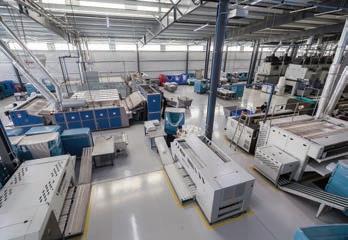
industries. He does it all and does it well.”
Like the first system, the new 12-module TBS-50 Eco-Tunnel operates with water reclamation, water filtration and drain-water heat recovery systems for maximum efficiency. Complemented by loading conveyors, presses, dual-cake delivery shuttles and 10 ST-100 Dryers, the tunnels process 5,000 total laundry pounds per hour—a 300% increase in production. Programmable by module, the tunnels use less than a gallon of water per laundry pound and complete 110-pound loads every two minutes.
They also require very little labor, according to Smith. One operator selects a customer number and program on the central computer screen and loads the tunnel conveyor. The tunnels automatically track, wash and dry each 110-pound load. While sheets are quickly separated in the dryer and fed into an ironing line while still damp, towels are completely dried and run through the laundry’s automated folding and
sorting systems.
Thanks to the tunnel addition, Smith enjoys peace of mind. If one tunnel fails, the other can operate at night to keep production on track. Although he could run two shifts, he prefers to keep it simple for now.
“We can wash north of 5,000 pounds per hour,” Smith shares. “Now the question becomes how many shifts? We process 12 million pounds in a single, 9-hour shift. If we ran two full shifts, we’d process 22 million. But, we don’t need to be that busy.
“We are a redundant shop in terms of the facility and equipment. But if something were to happen, we could use the other 15 hours a day to correct it. If one tunnel goes down, we can use the other at night to make up for it.”
On the ironing side, Quality Linen has three GI ironing lines and each features a chest ironer and corresponding folder/stacker.
“We iron sheets, scrubs, pillowcases and bath blankets,” says

10 NOVEM BER 2018 | AMERICAN LAUNDRY NEWS www.AmericanLaundryNews.com
Two Quality Linen operators clip sheet corners in a GI DRF Feeder to begin the automated ironing and folding process.
ALN_Tab_1-4_H.indd 1 9/10/18 3:14 PM See QUALITY on Page 12
The Quality Linen plant grew from 10,000 to 30,000 square feet in 2016. (Photos: Girbau Industrial)














70ºF80ºF Cold Water Wash Program for Hospitality Put the COLD in CLEAN SAVE ENERGY SAVE WATER SAVE TIME 1-800-442-4360 www.norchemcorp.com Our innovative system of 3 liquid products thoroughly cleans, deodorizes, and brightens room linens and towels without the need for hot water. ColdClean® works without the use of enzymes or any warm water mixed in while still delivering a brilliant clean. The ColdClean ® program includes a precision injection system for delivering formulas and is backed by our reputable technical support.
Efficient, flexible tunnel washers
Tunnel washers have made leaps forward in technology, productivity in the past 10 years
BY MATT POE, EDITOR
CHICAGO — Tunnel washers have been a staple for high-volume laundries for decades, but over the past 10 years, the multiple-module washers have seen some giant leaps forward in technology and efficiency.

“Tunnels today have much more flexibility in terms of design, water flows, controls and the ability to wash multiple products in the same run sequence,” says Keith Ware, vice president of sales for Lavatec Laundry Technology Inc., with U.S. headquarters in Beacon Falls, Conn.
“When we think back just five to seven years ago, some of the batch washer technology was still pretty mundane,” says David Netusil, manager-sales support and marketing for JENSEN USA Inc. in Panama City, Fla. “Sure, we were at the point where we were washing goods well below 1 gallon per pound, but we really hadn’t eclipsed the .5 gallon per pound threshold with truly excellent wash results.”
Steve Wilbur, director of engineering and product development for G. A. Braun Inc. in Syracuse, N.Y., adds that tunnel washers have achieved water usage rates as low as 0.3-0.4 gallons per pound. He feels that tunnels have likely gone as low as they will be able to in terms of water usage.
“One area that has benefitted over the past decade is the reuse of other plant heat sources to preheat incoming water and to reuse heated water within the tunnel process,” he says. “This has allowed tunnels to become very energy efficient surpassing most all other conventional equipment.”
Netusil says his company also sees the most notable and advantageous technological improvements in tunnel washers to be in water usage methods and water disinfection/ sanitation.
“In terms of water usage methods, JENSEN utilizes our patented QuickSoak technology, which is a very straightforward extra shower for the linen in the first compartment for maximum soaking, and saturation of chemistry,” he shares.
Netusil says disinfection of reuse press water has been achieved through the use of UV technology.
“This technology has advanced rapidly over the past two years or so and is producing some pretty extraordinary results,” he says. “This increases the amount of press water
Quality
Smith. “Adding automation reduced our labor costs and improved the quality of our final product.”
The GI ironing lines also process hospitality linens during the summer months, according to Smith.
Gas-operated and 93% efficient, the GI ironers automatically adapt cylinder speed according to linen type and moisture content—eliminating the need to pre-dry items. Rather, items are dried as they pass through the ironer, which boosts production and lowers natural gas usage, according to Smith.
Programmable to meet specific needs, the GI ironing lines require three operators each— two to feed and one to catch— and operate at speeds up to 164 feet per minute.
that can be reused due to a complete disinfection and oxidation of the press water, thereby decreasing water consumption and allows for a clean and sanitary press water tank.”
Darrell Redler, marketing director for systems for Pellerin Milnor Corp. in Kenner, La., says that in the last 10 years, the company has improved on its tunnel washer in two ways.
“First, we introduced the PulseFlow® batch washer in 2009,” he says. “This design changed the way we use counter-flow, an important feature of all Milnor batch washers, by postponing the counter-flow until it is most needed. Then in the last year or so we made the dual PulseFlow tank standard for all tunnels going forward. This allowed for better control over, and use of, the fresh water required in the washer.”
Tony Jackson, director of national accounts for Kannegiesser ETECH in Grand Prairie, Texas, shares that the Kannegiesser PowerTrans VARIO is a modern batch washer that combines flexibility, performance and the lowest total consumptions. Separate batch washing ensures precise process control of each single batch without any liquor mixing between neighboring batches.
He further shares that the versatility of a complete standing bath washing-and-rinsing system allows for color changes without the need for empty pockets. With the large drum volume and straight wall design, the PowerTrans tunnel creates a hygienically clean wash environment while keeping each batch separate.
Ware says Lavatec has developed systems to capture flushes from loads with different colors into reuse tanks, rather than losing that water down the drain. The next time a load with similar colors is injected into the tunnel, this water is brought back into the wash/wet out compartments
At the front of one of the ironing lines, a DRF multi-station spreader feeder automatically straightens items and feeds them into the ironer. The feeder addition further boosts processing speeds and ironing quality for amped production and a superior final product, Smith says.
Finally, a fourth ironing line, which is dedicated to healthcare goods, consists of a Chicago feeder, ironer and folder.
On the dry goods side, Quality Linen relies on two Foltex folders to quickly fold terry, thermals and gowns out of the dryer.
“Automation is important because this is a labor-intensive business,” says Smith. “It’s much more accurate and efficient to automatically fold items using machinery over hand folding.”
Finally, a hard-working openpocket wash line tackles niche laundry and heavily soiled items. In 2016 with the plant’s expansion, it added 620 pounds of capacity to that line. Comprised of E-Series soft-mount washers and complementing dryers, the
open-pocket wash line features one 55-, one 90- and three 255pound capacity washers.
“These are programmed for more mechanical action and longer cycles to clean heavily soiled items like napkins,” Smith says.
The line is reserved for about 20% of Quality Linen’s production needs, which include hospitality and food and beverage laundry. The soft-mount washers reach high extract speeds for moisture removal and quicker dry times—once again giving production a boost.
To ensure the best-possible clean, Smith uses Cleanovation™ Laundry Care System, a system that’s new to North America.
“We just switched our wash formula to a caustic-free, completely natural formula that kills microbes and provides for cleaner loads,” points out Smith. “Linens last at least twice as long and it’s environmentally friendly. The city measures our oxygen and phosphate levels. We have zero. We also get tested for
and effectively reusing the water.
Although some design enhancements have been made allowing for better lift and drop in a tunnel’s mechanical action, the primary factor that has changed is the ability to program the angular degree of rotation of the tunnel
microbe colony-forming units. If you score a 20 or less, you pass. We typically score a zero.”
At a time when the commercial laundry industry struggles to find quality labor, Smith doesn’t.
“We start employees at $10.25 per hour and don’t have difficulties finding help,” he says. “No one makes minimum wage; our working conditions are very nice, and we don’t experience much turnover.”
Today, Quality Linen serves a mixed market with a strengthened employee base, considerably more equipment automation, improved energy-efficiency and streamlined operational practices.
“Machinery, efficiency and production fall right into my wheelhouse,” says Smith, who grew up on a farm and has led a number of companies throughout his career.
Legally deaf since 1992, Smith regained his hearing after cochlear implant surgery a year ago. It’s no wonder he’s sympa-
thetic toward disabled workers. Since he acquired the struggling Quality Linen four years ago, he’s gone from five employees to 86. Several of them are disabled.
“One of my best employees is deaf, and I have two with epilepsy and several with autism,” he shares. “Some folks can’t do it physically, but if they can achieve 80% efficiency, that’s good enough for me.”
In the end, Smith’s goal is to provide a quality product and service to his community, along with happy employees.
“All decisions today are made with an eye on five years out,” he says.
Thus far, he’s achieved his goals. Quality Linen’s production has skyrocketed, but not at the expense of employees or customers. Quality, redundancy and efficiency are better than ever.
12 NOVEMBER 2018 | AMERICAN LAUNDRY NEWS www.AmericanLaundryNews.com
ALN
Haley Jorgensen is a public relations writer for commercial laundry equipment manufacturer Continental Girbau.
Continued from Page 10
15
See TUNNELS on Page
Tunnel washers have improved in technology, capability and efficiency over the past decade. (Photo: G.A. Braun)
ERNEST N. MORIAL CONVENTION CENTER WHERE THE INDUSTRY WORKS TOGETHER, LEARNS TOGETHER AND SUCCEEDS TOGETHER • 450+ EXHIBITING COMPANIES exhibiting over one-quarter-million net square feet • 11,000+ PEOPLE from 100 countries • EDUCATION sessions for all industry segments • LIVE DEMONSTRATIONS of the latest equipment and technology • NETWORKING with manufacturers, suppliers and industry peers For more information about Clean® 2019 visit us at www.cleanshow.com
Community partnerships may be answer to hiring challenges
BY GEORGE LATUS
BATESVILLE, Ark. — Hiring can be a tall order in our world. As we all know, being a backof-the-house department has its challenges. After all, even doing our own laundry at home can be a task many hate, or at the very least rank it fairly low on the household chores list.
Our laundry services a hospital as well as various clinics within the healthcare system we are a part of. So, our daily volumes are quite large. We are processing 1.5 million pounds annually and require a dedicated staff. So, add that busy, healthcare environment to an already lessthan-exciting task, and hiring can really be challenging.
However, we have had good luck in hiring a few people through a unique relationship we have with a group that supplements our full-time staff. I would recommend such an arrangement for other laundries as a means to address the often difficult hiring task and its equally trying sibling of employee turnover.
A COMMUNITY PARTNERSHIP
The nice thing about the laundry task is it is quite repetitive and easy to pick up. I’ve heard of some laundries partnering with organizations that represent and help empower mentally challenged clients. This is where the simple, repetitive tasks like folding become strengths and make them perfectly suited for outside partnerships with those organizations as a means to address hiring challenges.
Roughly 10 years ago our hospital board of directors, made up of, as you would expect, local business leaders—bankers, business owners, etc.—explored the idea of partnering with a Christian ministry that helps men in dealing with alcohol and drug addiction. These are not hardened criminals, and that’s definitely a distinction and something you’ll want to think about if you explore such agreements. You and your human resource department will undoubtedly
want to reduce risk and liability.
In our agreement, the ministry provides five men to assist our facility in meeting its daily production. The men benefit from being able to work at a steady pace doing a repetitive task. The arrangement is a win-win.
We pay a consideration to the ministry that amounts to state minimums for the labor of the fixed number of men (five). They also provide a group leader in charge of the men, which takes supervision off our plate as well. While we only pay for a set number of men, the ministry regularly brings double that amount to keep a large pool trained on the task.
These men complement our staff of four, and this relationship has been nothing short of a major success.
THE INSIDE TRACK
While this arrangement has been beneficial for both entities, over the last few years it has paid additional dividends for our organization when we have had a couple full-time openings pop up. Knowing the timeconsuming nature of hiring and training for this job, in addition to the turnover that many laundries experience, our arrange-
ment put the hospital in a great position to hire an experienced worker.
We had already had a “test drive” of sorts with these prospective employees. The time spent with these gentlemen showed not only that they could do the job, but they also had the right temperament for the position. I’m looking for an overall positive attitude and the general character of the individual, along with good attendance (we know the laundry doesn’t stop and people need to be here).
As an organization, we avoided hiring from this pool in the past, even with the six months we got to see them work in the program. As an added layer of security in our decision, we hired them first through a temp agency, which brought an additional three months to the probationary period. The human resources department was more comfortable going this route.
BUILDING ENGAGEMENT
I think a key component to the success of our full-time hires has been rotating staff. As we’ve discussed, the laundry environment can be tedious and repetitive. That’s what leads to the turnover of employees.
In our operation, staff rotates out. Because we process loads for clinics, staff might make deliveries and pickups. Equally important, I believe, is having them get on the floors of the hospital and interact with nursing and other staff.
Laundry staff isn’t tied down to just processing loads day in and day out. These interactions no doubt help create more job satisfaction. But I think the value goes both ways. It’s easy to view laundry pieces, whether piled up or neatly folded ready for the floor as just objects. But when staff is on the floors, they get to see those linens in use.
No longer are they “just laundry staff.” Seeing pieces in use and engaging with staff helps them see that they play a vital role in the facility’s operations. That type of mindset keeps them committed to quality and going the extra mile.
FINAL THOUGHTS
A laundry that faces a revolving door of staff members is not only inefficient due to the wasted resources put in to training someone who leaves, but also likely suffers in quality
because of the turnover.
Partnerships like the one our hospital has may be the answer for many laundries facing hiring challenges. After 10 years of this partnership, we couldn’t be happier with the results. The key component to our start was having the backing of the board of directors. Bringing human resources leadership around to the idea may require some work and insulating from liabilities, etc.
But the advantages aren’t limited to just doing something good in your community, while also meeting staffing needs. In our case, the test-drive period helped us make great hiring decisions when we needed to, which saved a ton of time and effort. I’m a big advocate of tapping into the community to develop a win-win scenario. ALN

George Latus is operations manager at White River Health System, Batesville, Ark. He also has the registered laundry linen director designation from the Association of Linen Management (ALM). He can be reached at glatus@wrmc.com. Latus

14 NOVEMB E R 2018 | AMERICAN LAUNDRY NEWS www.AmericanLaundryNews.com OPL 101
Author believes tapping into community can be a ‘win-win’ hiring scenario
(Image licensed by Ingram Publishing)
Tunnels
enhancing the effect of the rib design, says Wilbur.
“This allows for programming different wash angles for different types of goods and soil factors,” he points out. “The key to taking advantage of this is like goods and like soil factors must be run together as the programmed wash angle will impact all goods in the tunnel.”
Ware says varying mechanical baffles can alter the mechanical action to be as aggressive or gentle as necessary. Frequency inverters have also improved the flexibility on controlling the mechanical action by programming the speed and the rotation angle of the inner drum. It can be programmed separately in each wash program and specific to the individual item being processed.
Improved steam valves and double drum insulation also help to maintain heat inside of the tunnel for improved energy efficiency, Ware points out.

“Often our customers look to use cold or tempered water in the tunnel,” he shares. “This creates the need to heat tunnel water with steam injection, which is the most inefficient way to heat water. It takes nine times more energy to turn hot water into steam, compared to heating water through conventional methods.”
Finally, Ware says presses have become faster and with higher pressures to remove more moisture from the product to improve dryer efficiency.
Joseph Amaral, vice president of corporate sales for RAMCO Laundry Machinery Inc. in Arlington, Texas, says changes and upgrades to its press include going from 27 to 45 psi/bar pressing ability with 99 available programs.
“This allows us to extract more water from specific items and create programs to avoid damaging fragile items,” he says. “This creates less water, faster dryer times, less energy cost, fast turn time and great productivity.”
Controls have been one of the biggest advances in tunnel washers, in Ware’s opinion, with more precise data, drum rotation and speed, and having the ability to monitor water through induction meters to provide more precise water injections. This results in more precise temperature controls, chemical formulation and data collection.
Tunnel controls have evolved and migrated to almost exclusively touchscreen controls, Wilbur says. These controls have begun to incorporate artificial intelligence (AI) features.
“These AI features allow the tunnel to predict component problems before they happen, alerting both plant personnel
and the tunnel equipment supplier,” he points out. “They can tell mechanics when to do preventive maintenance steps, and actually show maintenance folks how to do them through the use of videos.”
“Since the late 1990s Milnor has used industrial PC-based controls to run the CBW washer’s main operational application, or Mentor,” says Redler. “Like all computer applications, over time they undergo many changes and improvements.”

In the case of Mentor, he says these improvements include the ability to handle more customers
“CLM
“I’m
and formulas, a more intuitive user interface, improved graphical displays, touchscreen controls, and the ability to communicate with non-Milnor systems using
data fusion techniques.
Amaral agrees that one of the biggest improvements in tunnel washers over the years has been in software and touchscreen capability.
“We have been able to use upgraded software improvements to pinpoint mechanical problems before and during failure or issues,” he says. “We can troubleshoot products and assist remotely. And schedule and send e-mails on preventive maintenance.”
Chemical and water usage can be programmed to a more accurate and precise measure to ensure high quality of product,





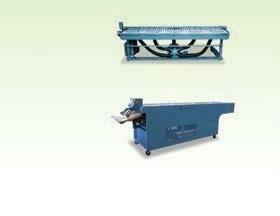
while reducing cost and waste, says Amaral. The ability to have more programs to specialize helps ensure the proper processing and overall care and cleanliness of the product.
“The management side has so many more functions and features, which include customer identifications, product selection, accounting and billing features,” he adds. “Not to mention the upgrades in material handling. You can move product, change production schedule system of goods being processed with the
“Your dryers are long-lasting. The PLC control is easy to use, helping to reduce cycle times, considerably.”
equipment has a good reputation: sturdy, reliable and e icient.”
really happy with my CLMs; they’re more than 20 years old and they just keep running.”
From the Pacific to the Atlantic, customers rely upon longevity of CLMs Pomona, CA | T: (323) 232-2417| clmco.com Robustly engineered long-lasting DRYERS Smartly productive and safe MAT ROLLERS Intelligently e icient SHUTTLE CONVEYORS Quick and easy-to-use VACUUM FEEDERS Clever and fast TOWEL FOLDERS All CLM equipment can seamlessly integrate into any laundry facility. Made in USA CLM ALN JR Ad Aug 2018.qxp_Layout 1 8/6/18 5:39 PM Page 1 ALN_Jr Page.indd 1 8/7/18 8:44 AM www.AmericanLaundryNews.com AMERICAN LAUNDRY NEWS | NOVEMBER 2018 15 Continued from Page 12
Since 1983, the CLM brand has delivered the most cost-e ective, most money-making shuttle conveyors, vacuum feeders, mat rollers, towel folders and its mighty line of 200-1200 lb. dryers. Come to the brand where long-lasting and low-maintenance equipment is standard.
See TUNNELS on Page 19
wash action today helps reduce water usage. (Photo:
Tunnel
JENSEN USA)
PANEL OF EXPERTS
When the floodwaters start to rise
pared to service your customers, protect your assets and maintain the integrity of your business after the event.

T housand-year floods seem to be occurring on a regular basis in many parts of the country. Unfortunately, these storms cannot be prevented, so how does a laundry owner prepare for an event that is not supposed to happen on a regular basis?
When determining to build a new facility in your market, the flood plain data provided by the government is often outdated. It will require utilizing an engineering firm to evaluate the site, look at elevations, distance from major rivers, creeks, bays or ocean to determine the potential risk of flooding.
In the event your property is in a small risk location, you can always look at the cost of elevating the building to dock height to help in the event of minor flooding. In real estate, remember the old adage: location, location, location. For existing plants that now find themselves in flood-prone areas, this designation may have changed due to population change, roadways creating more runoff flowing into rivers, and rising sea levels can turn what was once a safe location into one that is now at risk for flooding. Since moving your business is often not feasible, a good disaster plan may help alleviate losses.
Utilize your insurance carrier to assist in loss-prevention plans and develop an emergency operating plan for your business if the event you lose the ability to operate due to flooding. Evaluate your insurance coverage to see if in the event of a flood your business is covered—not just for immediate physical losses, but loss of business, inventory, etc.
Often in flood-prone areas, insurance carriers will not insure your business for flood. You may need to obtain national flood insurance coverage.
While major flooding cannot be prevented, you should be pre-



We will certainly hear of operators who recently went through Hurricane Florence. It has been almost two weeks since the storm has passed and towns that were not immediately affected by the rains are now under extreme, sunny weather flooding, due to the immense amount of water flowing from upstate toward the coast. Land that was dry four to five days after the storm passed are now under water.
You cannot prevent flooding, but in future choices, you can lower your risks by selecting sites with low flood risk or preparing your emergency plans in the event, and finally reviewing your insurance coverages so in the event of a catastrophic flood, your business is properly insured.
with your gear and from their support. Incorporate what you learn into your plan.
If the facility is on grade and the water is of a flash-flood nature, things as simple as sandbagging one level high at the entrances can help reduce the amount of clean up you will have to do afterwards.
There is nothing like an easy answer for this type of question. As the water rises around, and then into, your facility, you know that there is nothing that can be done to stop the water from rising until it decides to recede.
There are a number of things you can do to discourage the water from entering and taking up residence, and most of them require preparation and experience at your facility.
One thing to consider is having pre-arranged plans to shunt your processing to another facility (preferably several others) while you are inoperable. If you don’t have a Memorandum of Intent or reciprocal agreement with other facilities, both local and further away, consider doing so now and have the peace of mind knowing your “plan E” is prepared and ready—if it comes to that.
Consider asking your equipment manufacturer about these kinds of events and what to expect
Making sure that all storm drains on or near your facility are free of debris and trash help the drainage flow better and will increase the amount of water they can channel away. Reporting any drains that flow poorly or are blocked now will give your municipality time to address the issue before it is too late.
Keeping unnecessary traffic from coming and going can keep the water from spreading from the waves. Blocking off the paved areas outside to limit vehicles creating wakes is helpful. If you have sumps, be sure to have backup power for the pumps in case of interruption in electrical service.
Once the water is about to rise over your defenses, be sure that you are ready and able to cut the utilities to your facility and equipment to avoid shorting, fire and electrocution hazards.
Boilers and thermal equipment will react poorly to cold water, so be sure that they are not only turned off, but are as cool as possible. Be sure you have all of your linens picked up and preferably in carts as well as in the highest areas of the facility.
Now is the time to activate your reciprocal agreements and complete your alternate plan execution. If you have planned to distribute from an alternate location, begin moving your product. Check your spare parts stock and ensure that your electronic components are on the highest shelves. If water rises to engulf your control equipment, go ahead and call your manufacturer or the technician and share the news so they can prepare for an effective recovery time on your equipment.
When I experienced a hurricane, the biggest issue in our cleanup was the lack of power to operate greatly needed equipment to do the job.
Many things that are not only unexpected but arise contingent upon something else not considered will keep you adapting your plans; don’t be daunted and stay focused. One day you will have another opportunity to capitalize on how much you have learned from this event.
out the summer and early fall seasons. We also have to be prepared for the potential for hurricanes every year that can produce more than a foot of rain.
Our resort has an engineering team dedicated to checking and clearing storm drains around the operations area on a regular basis, as items can quickly stop up drains and cause flooding into the laundry. This team will also periodically check the gutters to prevent water buildup on the roof, as we have flat roofs instead of sloping roofs.
We closely monitor with security the weather radars and local media to coordinate ahead of potential heavy storms the needs of the operation. I have direct weather radars and warnings on both my office computer and my cell phone. All bay doors and other doors will be secured as a storm is approaching. In addition, we will move any vehicles, such as golf carts or trailers, away from potential flooding areas.
The laundry operation has a small storm-related safety team that proactively looks at what we can do to protect the laundry from flooding, and they provide insight into having a plan ready at all times. They would actually stay on site in the hotel in the event of a major flood event or hurricane and be responsible for shutting down the operation and protecting the laundry equipment with plastic if necessary.
That team would then be first on scene to evaluate and safely determine any recovery effort needed and report back to management. This is also important to look at, as during heavy flooding many of your laundry team may be unable to get to work even though the laundry may be intact and ready to operate.
Every laundry has different situations based on location, but careful and complete guidelines and continual training are important to have in place. We have an annual simulation and readiness evaluation for different potential disasters, including flooding or hurricanes.
Working in Orlando provides heavy rains and potential flooding almost daily through-
It is too late to think about what to do when something actually happens.

16 NOVEMBER 2018 | AMERICAN LAUNDRY NEWS www.AmericanLaundryNews.com
“The past few years, it seems like more storm-related flooding is going on. How can I help protect my facility, my equipment and textiles, from this? Help ensure my operation keeps running?”
ALN
Equipment Manufacturing Keith Ware
Lavatec Laundry Technology Inc. Beacon Falls, Conn.
Hotel/Motel/ Resort Laundry Phil Jones, CLLM Vistana Signature Experiences Orlando, Fla.
(Image licensed by Ingram Publishing)
Healthcare Laundry
Richard Engler, CLLM John Peter Smith Health Network Fort Worth, Texas
Your table linens touch every Customer at every event. Your linen needs to speak their language… fresh, clean, safe, consistent, reliable, and yes elegant. They count on it.


Together, ADI and Milliken have set the standard of linen excellence for decades. USA made Signature Plus fabric. Soft luxurious hand, consistent long-lasting color. Whites that stay white, and colors that stay bright.
ADI American Dawn. The world’s leading supplier of Milliken Signature table linen products. Count on us. Signature Plus is a registered trademark for Milliken & Company for fabrics.

800 821 2221 | imagine@americandawn.com | americandawn.com
COMPLETE YOUR TABLE WITH MILLIKEN LINENS BY ADI
says that as healthcare systems up their efforts to raise patient satisfaction levels—to earn better reimbursement rates, in part—they see opportunities to use textiles and apparel to help them.








“One need not search much further than Eric Frederick’s recent first-person account of his hospitalization [October 2018, page 4] to see that yesterday’s fabrics, designs and linen service can no longer be
the norm,” he points out. “Just as cotton-fleece sweats no longer cut it as high-performing athletic apparel, healthcare bedding and apparel is becoming more performancebased on a daily basis.”
One of the measures of patient satisfaction on the government’s Hospital Consumer Assessment of Healthcare Providers and Systems (HCAHPS) survey is communication levels and understanding between facility staff and the patient and their family.
“If a patient has a difficult time telling who is a nurse vs. an aide vs. a lab tech because they are all wearing the same outfit, how are
they going to respond to the survey questions around clear communication?” asks Przepiorka. “Our research has shown that at least two-thirds of all hospitals have employed a color-coded uniform program for their patient-facing staff in an effort to help patients and family clearly identify who is the nurse and who is the doctor.”
Now that more and more employees are wearing uniforms, in many cases with the facility logo, they, too, are demanding more from their clothes, he points out. Synthetic-rich, home-wash performance fabrics are fast becoming the norm in retail scrubs, replacing the


old 65/35 and 50/50 stalwart blends of the past.
Przepiorka believes it is only a matter of time before operating room scrubs, still purchased and processed mostly by healthcare laundries, move to more performance-based fabrics and designs as well. Initial 100% polyester efforts have fallen short, but improvements are coming.
“Institutional laundries may need to alter their processing methods to adapt to the new fabrics to meet their customer’s requirements,” he says. “With their treated fabrics and delicate stretch components, these new scrubs will pose a laundering
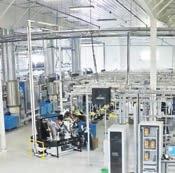

challenge, but offer opportunities for enriched customer relationships if they get it right.”

The focus on patient satisfaction has raised the expectations of the simple patient gown to offer more comfort, dignity and performance than ever before, shares Przepiorka. Synthetic blends, softer fabrics, brighter and more stain- and faderesistant prints and designs, and better coverage (while still allowing for fast and easy clinical access) will be the new normal in patient apparel.
“This should add up to easier processing and less energy use for laundries,” he says.
Just as uniform programs and better patient gowns are intended to increase patient satisfaction, the design and ambience of the patient rooms and the overall hospital environment is moving toward a hospitality and home-like feel, Przepiorka shares.
“Research has shown that healing and recovery are faster and better in a more comfortable environment,” he says. “Performance-based fabrics are coming to the patient environment as well. Cotton will fade away for polyester that is designed to feel like cotton but enhance the microclimate around the patient’s skin. For all the high-tech medical devices and supplies used in healthcare, only fabrics are touching and surrounding the patient 100% of the time they are in care.”
Sheets, incontinence products, blankets as well as gowns are now being designed to remove pressure and moisture away from the patient’s skin, and to work in conjunction with the new wave of pressure-reducing therapeutic beds and mattresses to help prevent skin breakdown, Przepiorka says.
“The good news for laundries is that these are in many cases easier-to-care-for fabrics and articles that are more stain-resistant and faster-drying,” he shares. “The flip side is that the acquisition cost will increase, but the overall cost per use should be lower due to much longer life cycles if care for properly.”
Another wave coming with the preponderance of synthetic knits is the no-fold linen system, Przepiorka says. Knitted bottom and top sheets, pillowcases and patient gowns can be delivered in bags unfolded and unwrinkled, speeding up post-processing and redelivery times.
“Granted, old habits die hard in both the nursing unit and the laundry, and change is not for everyone,” he admits. “But for those have embraced the no-fold systems, especially in-house laundries, the benefits have far outweighed the cost of change.”
There are many threads the laundry and linen service industry needs to keep track of when it comes to textiles. Some are challenging; some are positive. But all are sure to make an impact in the coming year.
“All in all, other than the China tariff impact, we expect a good year in 2019,” Kallenbach concludes.
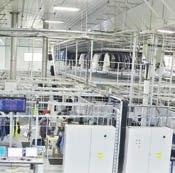
18 NOVEMBER 2018 | AMERICAN LAUNDRY NEWS www.AmericanLaundryNews.com
Continued from Page 8 Textiles Join the 200 linen, uniform and facility services operations whose companies get a competitive edge from the largest and fastest-growing laundry certification. Promoted by TRSA directly to your customers, Hygienically Clean attests to laundries that deliver a higher level of clean, differentiating them and maximizing customer confidence. Contact: Angela Freeman, 877.770.9274, ext. 111; afreeman@trsa.org VERIFYING PRACTICES, QUANTIFYING CLEANLINESS HC_ALN_Jr_Pg.indd 1 8/2/18 6:59 PM ALN_Jr Page.indd 1
ALN
touch of your fingertips.”
Wilbur says the big change in tunnel washer chemistry over the past decade is a move to use peracetic acid-based chemistry, which in turn allows for processing goods in lower temperatures, thus saving energy throughout the tunnel processing.
Redler says that one of the issues with continuous counterflow was that it made for continuous dilution of soil which was good, but with that came a dilution of the chemistry which meant higher dosing to compensate.
“PulseFlow washers allowed the chemistry to work during the standing bath phase of the transfer cycle, resulting in chemical savings without any loss of quality,” he says.
Braun’s batch washers utilize Braun’s Tunnel Infusion Technology throughout the tunnel, Wilbur says.
“This trademarked fill process technology consists of adding water and chemistry above the goods providing superior agitation and mixing,” he says.
One area of the tunnel washer that hasn’t changed all that much is its footprint. However, Wilbur says that the benefits afforded by developments in the chemical field, and those already noted regarding mechanical action, have allowed shorter tunnels (fewer chambers) to increase their effective output.
“This along with the improved efficiencies of today’s dryers can free up some valuable facility space,” he says.
Jackson shares that the VARIO is built to reduce waste with intelligent water management, maximized loading volumes, and efficient rinsing times. Customers are also able to produce the highest possible output within the available space due to the efficiently designed footprint of the systems.
Tunnels are used in almost every industry from healthcare, to hospitality, to food and beverage and everything in between. There are many factors that a prospective tunnel purchaser needs to consider, but probably one of the key factors is mix, and current and projected volume. Tunnels fall off on efficiency when used in low volume situations, so that is probably the key factor to consider first, Wilbur points out.
Ware agrees that determining what size tunnel is best for any operation is the key to success for operational efficiency.
“Utilizing a large-capacity tunnel for smaller COG accounts does not make sense, since most of the compartments will be under loaded,” he says.
However, Wilbur does say that
with the increase in efficiency, the return on investment (ROI) for the purchase of a tunnel system has become more attractive to the smaller users.
Ware says laundries also need to determine what they want to process, how diverse the product mix is, and if they have the space, budget and return on investment for developing a tunnel project. The driving factors are labor, utilities, throughput and efficiency.
“For example, we worked with a company that primarily had washer-extractors,” Ware shares.
“The reason to move to a tunnel
to work in the washdeck area and reduce the significant number of workers’ compensation injuries in their plant. Working together, we found a solution to help with this issue. We also improved their operating costs and reduced utilities.”
Redler says the main factors that dictate the use of tunnel washing are minimum output requirements and whether or not the plant is capable of supporting the equipment.
“Beyond the purely physical aspects of sizing and output, the costs involved for the equipment are usually near the center of
considering the cost savings due to the inherent rationing of water and utilities, and the labor-saving benefits possible through automation, a reasonable payback is typically realized.”
Tunnels will continue to improve quality, flexibility and energy conservation in the future, Ware says.
“I believe that tunnels will develop more intuitive controls for chemistry of varying load weights,” he says. “Considering that the number of highly skilled maintenance engineers is not keeping pace with industry

should focus on simplifying the tunnel system. Predictive maintenance will become more important as laundries utilize their resources more effectively and over longer operating hours.”
The biggest improvement of a tunnel washer’s throughput in the future will be improving speed of the extraction presses and removing moisture faster, with less damage to the linens being pressed, Ware says.
“Undoubtedly, design engineers are always working on the ‘next big thing,’” says Netusil. “What will they come up with?

Kannegiesser ETECH • 2090 Elm St. SE • Minneapolis, MN 55414 • phone: (612) 722-1366 kannegiesser-etech.com • info@kannegiesser-etech.com Our Systems Performance Team is committed to everything that matters to your success. Now 80 service members strong, we focus on providing expert level installation, commissioning, training, optimization, technical support and parts service. We’re backed and supported by deep company resources, local and abroad, with a true passion for making our customers successful for your customers. Services we provide: • 24/7/365 phone and online technical support • Local spare parts • Customer training seminars • On-site installation, testing, commissioning and training • On-site service (preventive maintenance, system analysis, system tune-up, customer training, system optimization) • Remote online training sessions “From our team to yours, we are excited and proud to be a part of your success!” – Tony Schult, Director of Systems Performance Want to learn more or set up a System Performance Review? Call Tony Schult at (612) 722-1366. EVERY KANNEGIESSER ETECH SYSTEM IS BACKED BY A TEAM DEDICATED TO ITS SUCCESS. Annual Kannegiesser ETECH Service Summit 2018 C M Y CM MY CY CMY K KE_ALN June Ad_7_75x10_f01.pdf 1 6/5/18 1:37 PM ALN_Jr Page.indd 1 6/5/18 3:36 PM www.AmericanLaundryNews.com AMERICAN LAUNDRY NEWS | NOVEMBER 2018 19 Continued from Page 15 Tunnels
Fundamentals of ironing review
BY MATT POE, EDITOR
RICHMOND, Ky. — Most laundry and linen service professionals are familiar with the fundamentals of washing, also known as the laundry pie: chemistry, mechanical action, time and temperature. All of these factors affect wash quality.
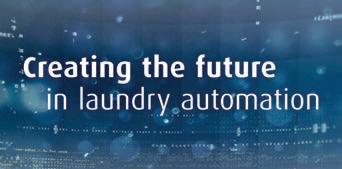
Just like there are washing fundamentals, there are also ironing fundamentals.
Amanda Lobb, sales manager with Lapauw USA, discussed the fundamentals of ironing during a recent Association for Linen Management (ALM) webinar entitled Smooth Moves: The Fundamentals of Ironing.
The basics of ironing, she says, include suction, the removal of moisture from a product as it goes through the ironer; time, referring to the speed and amount of time it takes for expected throughput; pressure exerted on the product, depending on the type of ironer; and temperature, which will differ with the type of textile being
processed.
“All four of these pieces directly impact what you can expect to come out of your ironer and the performance of your ironer,” Lobb says.
FUNDAMENTAL IRONER TYPES, TEMPERATURE

There are two types of ironers available to laundry operators: roll-heated and chest-heated.



According to Lobb, roll-heated ironers are used more in smaller production operations, not laundries that are doing a lot of highspeed production. The difference between roll-heated and chest ironers is that the roll-heated machine doesn’t have a chest.
“Your textiles are going into the ironer, and they’re being held against the roll or the cylinder by a series of belts and pulleys that are holding the linen onto the roll, and sending it through the machine, somewhat adding pressure,” she says.
Then there are chest-heated ironers, which can be either thermal or steam-heated. The chest-





heated ironer, rather than having a series of belts and pulleys to pull the linen through the ironer to process, dry and press it, takes the textiles into the machine in between a hot metal chest and a roll, Lobb says.
“The concept of a chest-heated ironer is similar to how you would think about ironing at home,” she shares. “You have an ironing board, and you have a pad on the board, so your iron would be the hot chest, your pad would be the iron itself the padding around it.
“That would signify what you’re trying to do. You’re applying pressure with the iron in your hand against a pad that absorbs the moisture, and you’re
20 NOVEMBER 2018 | AMERICAN LAUNDRY NEWS www.AmericanLaundryNews.com
Basic procedures, regular maintenance affect ironer performance, quality of goods processed Proper temperature is a fundamental of ironer performance. (Image licensed by Ingram Publishing) ALN_Jr Half.indd 1 9/21/18 2:03 PM 6075 Hopkins Road, Mentor, OH 44060 • Ph: 440-257-6453 • Fax: 440-257-6459 • Email: downassoc2@oh.rr.com Spring 2018 Issue - 1/4 pg ad Environmental solutions healthcare Covering infection prevention, medical waste management & McClure Industries, Inc. 800-752-2821 fax 503-775-2828 Sani-Trux Call 800-752-2821or Fax 503-775-2828 or Email sanitrux@mcclureindustries.com for McClure Industries, Inc. and Sani-Trux
Sani-Trux is the only molded cart to pass rigorous
laboratory testing for NFPA re codes.
cart
poly cart.
•
independent
• Made of durable berglass making the
life at least twice that of a
• Easy to maneuver even in tight spaces.
T IM E TO O RDER ALN_Jr Half.indd 1 3/15/18 1:14 PM
• Built with quality components to last years longer than other carts.
pressing and creating finishing and removing wrinkles at the same time.”
On a roll-heated ironer, temperature is distributed through the roll itself, versus a chest-heated ironer, where the temperature source comes on the underside of the chest, she says. It’s a selfcontained unit if heat is coming through gas; if by steam, it will be serviced by a boiler.
Of all the equipment in a laundry, the steam-heated ironer is one of the largest consumers of steam, explains Lobb. The primary maintenance a laundry needs to do to maintain temperature of a steam-heated ironer is to be sure of proper steam pressure.
“Even when you purchase the machine, if you are, for example, a hotel OPL laundry and you are looking to purchase a new ironer, it’s important for you to understand how much pressure you’re getting,” she points out. “If you’re only getting 105 psi versus 120 psi, that’s going to impact the amount of throughput and the type of equipment decisions that you’re going to make.”
Lobb adds that a laundry has to make sure the proper amount of steam is consistently getting to the machine. Condensate builds up, and it’s very important to clean steam traps and maintain them on a regular basis. This is where a laundry loses energy, loses heat and ultimately loses throughput in the production on a steam ironer.
Similarly, Lobb shares that laundries need to make sure all steam and condensate lines are insulated to preserve the energy lost.
“There’s a significant amount energy and temperature and heat lost between the boiler itself and the ironer, just depending on the distance of the boiler from the ironer,” she says. “The longer the distance, the more important it is to make sure that these lines are properly insulated and that the insulation is maintained.”
Also, inspect piping on a regular basis, looking for leaks. Although leaks can be small, it can get very expensive across multiple ironers every day in a laundry, Lobb points out.
Ironers are usually either gasheated or thermal-heated. She says roll-heated ironers typically use gas.
A thermal-heated ironer uses thermal-heated oil, and this can be either through a boiler or a steam-style ironer where it’s selfcontained, or the laundry is using a thermal-oil boiler to heat the ironer just like a steam ironer.
“A self-contained ironer is going to be less maintenance in terms of parts and components and boiler certification, and so on,” Lobb explains. “We call these fully integrated systems.
“A self-contained system is where you’re heating thermal oil in a heat exchanger and that oil is pumping into the chest of the ironer, and going in and out,
returning to the burner to be reheated and recirculated through the machine, much like steam and your condensation would go back to the boiler to be reheated and come back to the ironer.”
She recommends that laundries consult manufacturers about the kind of oil used in a machine, because oils are different. They have different detergents and viscosity, and a laundry can experience clogs in the chest and problems with throughput and heating if the manufacturer-recommended oil isn’t used. Thermal fluid ironers can be heated remotely or be self-contained.
The key is to use the proper
temperature use for all textiles, says Lobb.
“The beauty of all these machines is they have a good temperature range, and it’s really important that when you buy a new textile or you agree to process a new product from a customer that you understand how that product is supposed to perform,” she points out.
“It’s very important to understand when you’re considering processing a product, what are the temperature parameters both for the wash and for the finishing process to make sure that you not only finish the product well and maintain the product well and
hold down your linen replacement costs.”
WAX, VACUUM FUNDAMENTALS
When a laundry sees poor quality coming off an ironer, Lobb says there are a couple factors to consider. For a chest-heated ironer, one would be wax buildup or over waxing.
“You may be running your product in the same position all the time, and you’ll get wax buildup and chemical distribution on the sides where maybe you’re not processing across the chest,” she says. “That can cause accordion folding coming out of
your ironer, or what looks almost like it stutters through the ironer and is having a problem coming out of the machine. That’s because the surface of your chest is meant to be nice and smooth. And when you either over wax or get chemical buildup and disposition, it creates friction and poor finish and poor throughput on the ironer itself.”
To avoid this, Lobb recommends using a cleaning cloth daily. Waxing varies from operator to operator, and sometimes it can even vary from day to day, depending on how much the
SMOOTHFLOW
BATCH TUNNEL WASHING SYSTEMS
[NEW Technology Backed By Science!]
Open Helicoid Cylinder Design

Enhances the wash pie by providing mechanical action consistent with that of an open pocket washer without the limitations imposed by transfer scoops or an archimedean design.
Safety
Monoshell helicoid provides for a large transfer opening and the unique friction drive system eliminates the need for access hatches and operator entry into the processing vessel. Braun also provides patent pending chute loading dryers.

Energy
Our standard systems afford the ability to support low and high temperature chemistries with limited energy consumption.
We also offer a steam generator package to avoid the costs associated with boiler rooms and stationary engineers. As a full line dryer manufacturer we offer industry leading production and energy efficiency while optimizing the use of facility space.


Water Efficiency
Exceptional wash pie balance associated with these solutions allow for low water consumption (.4 to .7 gallons/lb., depending on soil type), while affording extremely low rewash rates (2% or less). This is not only efficient, but it improves linen life. All water used in the process is reused at least three times in the process!
Hygiene
The unique combination of material science and the monoshell design enhance system resistance to microbial/bacteria growth. All process piping is stainless steel and this system avoids double drum stagnant surfaces.
Reliability
Braun has been supplying tunnel system solutions to the industry for well over 35 years, and does so providing easy to use, heavy duty equipment that “stands the test of time”. We also provide the most comprehensive post sale support system to insure that our clients maximize performance and equipment longevity.
For more details on the proven Science of Braun’s unique features and functionality, go to www.gabraun.com/science

AND THAT’S NOT ALL! ISO 9001 Certified I Made in the U.S.A. I gabraun.com THE DIFFERENCE
.
ALN_Jr Page.indd 1 10/2/18 9:44 AM www.AmericanLaundryNews.com AMERICAN LAUNDRY NEWS | NOVEMBER 2018 21 See IRONING on Page 22
®
Ironing

laundry is producing.
“A good rule of thumb is to wax at startup, wax again at lunchtime, and you may want to wax one more time during the day, just depending on your throughput,” she suggests. “Sometimes if you see that you’re getting any kind of brown residue, getting a buildup, some folks can get away with waxing once a day and just using the cleaning cloth on a daily basis.”
Whatever type of ironer is being used, Lobb says that the vacuum needs to be turned off for waxing.
“If you don’t turn the vacuum off, what happens is your pad will get clogged with wax, and it will pull the wax through the suction and get into your ductwork as well,” she says. “You also want to run a scouring pad to make sure the chest is clean.”
Lobb recommends waxing two to four times a day. Use the wax sparingly, but often. She also says to make sure the wax cloth is kept neat and clean by storing it on a rack or folded when it’s cool.
“I don’t know if you have ever tried to pick up a wax cloth that has been improperly discarded, but they get very stiff,” she says.

“They are a very heavy cotton fabric, and dried, cooled wax makes them very stiff and very hard to work with. I can promise you that operators need things to be easy and simple to maintain good behaviors when it comes to waxing and all kinds of maintenance when it comes to your ironers.”
Finally, Lobb says proper temperature is necessary for good waxing.
“If you don’t have enough temperature in the wax, the wax is not going to melt and lubricate the chest,” she says. “It’s not going to be really useful at all, and you’ll have additional redisposition on your textiles.”
In addition to using a scouring pad on a regular basis, Lobb says a laundry will want to do a heavy cleaning annually. For heavy cleaning, the scouring pad is placed around the roll and then it is run for about an hour on the chest to completely clean it from one side to the other.
Lobb recommends always using a wax cloth and not placing wax directly on the ironer. The cloth has pockets for wax paste or flakes.
“If you feel like you put too much in there, I would always follow your wax cloth with defective or to be ragged-out sheets or table linen to run through a couple times just to pick up any
excess amount from the waxing process,” she says.


FUNDAMENTALS OF PRESSURE
Assuming that chests are clean and waxed, pressure is probably the most important aspect of ironer processing, according to Lobb. Pressure is created by padding and springs around the roll.
“As your pad wears, you’ll have less contact with the chest itself, so, it’s really important to make sure you are changing your pad on a regular basis,” she points out. “Check manuals, consult the supplier, the rep in field as to how often to change pad.”
Lobb also says the right type of padding needs to be used. Two types of padding are available: polyester and Nomex. The choice depends on ironing temperatures. Ironing below 365 F can use a polyester pad. Higher temperatures require a Nomex pad, since the material has a higher heat tolerance.



There are also different kinds and weights of pads, specifically for roll-heated and chest-heated ironers, so she recommends consulting the ironer manual or company representative.
Lobb says springs are wrapped around the roll of an ironer, much like a pad is, or springs can be independent, where each
spring is individually placed or replaced in an ironer in the roll.



“What springs do is they provide consistent pressure, which is absolutely necessary,” she explains. “Springs are also where moisture removal comes into play. The holes you see in the roll are were your moisture escapes your linen and pulls it through the machine, so it’s really important that you maintain your springs.”
While moisture escapes through the holes in the roll and through the springs, the vacuum is pulling moisture from linen, through the pad, through the springs, through the roll and then out through the exhaust on the machine, Lobb says. It’s important that vacuum fans are working and that ductwork, ventilation, is clear.

“Ductwork on ironers needs to go straight up to the roof if at all possible,” she recommends. “You want to avoid bends as best you can so you can minimize and avoid any kind of back pressure and end reductions in suction.
“If you’re not getting good drying and you’re not getting good suction, after you check the vacuum, the ductwork is a sure place I would look as well. Sometimes you get wax buildup, if you have too many hard bends, this will definitely create a chal-





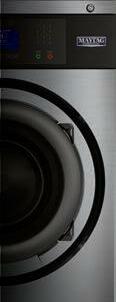











lenge for moisture removal.”
MAINTENANCE FUNDAMENTALS
Lobb recommends maintenance of an ironer on a regular basis.
In general, on any ironer, she says a laundry should be lubricating the machine and checking the feed belt and guide tape. Some ironers use scrapers instead of guide tape to guide linen off the roll, and those scrapers must be maintained.
She also says that laundries should do blowdown.
“I want to be careful when I say blowdown,” Lobb cautions. “I know that everybody starts at the top and blows down all the lint and dust and dirt in the plants, and then you kind of work your way down and out of the laundry itself. But it’s very important with an ironer that you don’t blow in dirt.
“The quick and easy habit that I see happen pretty often is, we’ll take the air compressor, we’ll be walking around, we’re blowing off the floor and blowing off the rafters and maybe we’ll blow under the ironer. Under the ironer, out from under the ironer is fine. Blowing sensors, blowing air into the side and control boxes and things like that are really not a good idea.”
Lobb recommends using a shop

22 NOVEMBER 2018 | AMERICAN LAUNDRY NEWS www.AmericanLaundryNews.com NEW MAYTAG® MULTI-LOAD WASHER
Continued from Page 21
ALN Tab half spread with ALN Tab half spread with
vacuum to clean inside panels, controls, sensors and other sensitive parts in flatwork finishing equipment to avoid pushing dirt and lint further into the machine. Not only can that cause long-term maintenance issues, but more importantly it can cause fire.

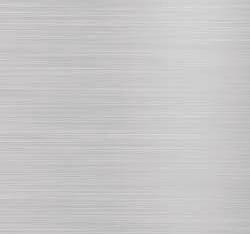

“Sometimes we overthink what it takes to keep something clean,” she says. “A simple device I’ve seen is [the laundry has] taken a rope and run it across the belts, picking up the lint, and they can just clean that rope once in a while, doing the job of cleaning
those belts all day long, every day. A simple, straightforward, easyto-maintain idea.”
Lobb recommends several areas of an ironer be checked on a daily basis, starting with safety features. These include making sure emergency stop buttons work; making


sure the finger guard not only works, but also that it has not been adjusted; and that guards on the doors, the panels and other areas of the machine are in place.

“You also need to look for warning signals on startup, especially if your machines are newer,” she says. “This a little bit more tricky with older machines. Of course, you can listen, if you know your machine and you’re hearing sounds and it’s doing things you wouldn’t normally expect obviously are warning signs.
“On your newer machines, you have a PLC with a touchscreen a lot of times that will feature any kind of warnings that you need for an inverter to be reset or a power issue, any of those types of things. Pay attention to what your machine is telling you. These machines are getting smarter and smarter every day.”
Another daily maintenance check she recommends is padding, as well as feed and exit belts. And check for any signs of leak, whether it’s a steam leak, an air leak, an oil leak, etc.
“You want to check for those kind of things, because that will reduce your down time, as well as make sure that you are maintaining proper temperature,” says Lobb. “For example, if you had a thermal oil leak or a steam leak, that’s going to make a significant
impact on your throughput.”

































On a weekly basis, she says to clean all fans, checking oil levels in gear boxes and hydraulic pumps, and thermal oil reserves. Also, check steam traps and how they’re performing, making sure that there isn’t condensation building up. Clean the ribs on the inverter and clean the electrical box.


“You want to make sure you’re not getting a build-up of dust and dirt and things around the items that can spark fires and/ or prevent throughput,” Lobb points out. “Make sure that you clean burners and gas train. A lot of times your burners and your gas trains are separate from your actual machine.”
Monthly, she says to check the heat exchanger, seals, chain tension, carbon brushes, grease chains and nipples. Annually, change gearbox oil every number of hours, and get the boiler checked and certified to make sure of proper operation to service steam ironers.
“Always use the correct oil, padding and springs,” concludes Lobb. “I cannot express enough not to cut corners on what your manufacturers recommend. They are the experts in their machinery and they want you to be successful as well.”
www.AmericanLaundryNews.com AMERICAN LAUNDRY NEWS | NOVEMBER 2018 23 *For complete warranty details, visit maytagcommerciallaundry.com. ®/™ ©2018 Maytag. All rights reserved. DEPEND ON COMMERCIAL- GRADE COMPONENTS EXPECT WORKFLOW OPTIMIZATION RELY ON CUSTOMIZABLE CONTROLS Learn more about opportunities to increase operational efficiency at maytagcommerciallaundry.com * with bleed ad template with bleed ad template Ironer maintenance checks should take place daily, weekly, monthly and annually. (Image licensed by Ingram Publishing)
ALN
AMERICAN ASSOCIATED COMPANIES

American Associated Companies (AACO) is a manufacturer and distributor of reusable textile products.

AACO’s product line includes ready-made garments, which include a variety of workwear products, including white and black kitchen shirts with pockets. These products are produced in heavy weight spun polyester and utilize versatile manufacturing construction and sewing to ensure long lasting durability and overall product life, according to the company.


The company also provides a variety of industrial, healthcare and hospitality terry, kitchen and bed linen products, and distributes its products from its manufacturing facilities and customer service and distribution centers.

AACO says it utilizes its strong product knowledge and selection combined with nationwide distribution capabilities to provide customers with a tailored solution for their textile needs.
www.aaco.com 800-849-7060
ENCOMPASS GROUP


Encompass Group LLC, a manufacturer and marketer of reusable textiles, professional apparel, and disposable and single-use medical products, has introduced its Five Star® Short Sleeve Moisture Wicking Mesh Back Chef Coat.

The tightly knit mesh back panel provides full coverage yet allows breathability and comfort for the hospital or senior living food service professional, Encompass says. This coat is a high quality, durable option that is value priced and withstands the rigors of laundry processing.
The Five Star® Short Sleeve
Moisture Wicking Mesh Back
Chef Coat is made from a durable poly/cotton poplin with added soil release treatment and has a polyester mesh back treatment. The coat comes in white or black and is offered from size XXS to 5X.
www.encompassgroup.net 800-284-4540


FASHION SEAL HEALTHCARE
Fashion Seal Healthcare®, a brand of Superior Uniform Group, says it considers the comfort of healthcare staff and









patients with SimplySoft® scrub and patient apparel offerings.
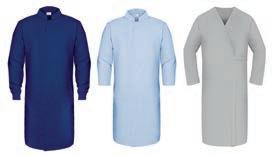
The 65 poly/35 cotton, softto-the-touch fabric offers the strength to stand up to industrial laundries, according to the company.


While scrubs focus on fashion, patient apparel focuses on modesty, and each can maintain the functionality and endurance required for laundry and healthcare environments. According to Fashion Seal Healthcare, it is a blend that balances comfort, durability and ease of care.
www.fashionsealhealthcare.com 888-491-5818
ADI AMERICAN DAWN

ADI American Dawn says it is the new manufacturing leader in hazard analysis and critical control points (HACCP) food safety cover/service apparel.
With the industry’s exclusive hidden gripper closures, ADI says its HACCP line features no-pocket lab coats, with or without knit cuffs, as well as wraparounds to match. Made from Milliken USA fabrics, the company says its 100% spun polyester construction offers a life cycle of 80-100 processes.
ADI adds that its products help businesses differentiate themselves in the massive and quickly growing food and pharmaceutical manufacturing channels.
Along with the company’s exclusive line, stocked in seven colors, as well as many other made-to-order colors available, ADI offers direct field sales support. It says its dedicated, valueadded services manager will help target, sell and close large apparel accounts.
Also, large HACCP accounts look for third-party verifications of their HACCP plans, and ADI says it will provide this support at no cost.
www.americandawn.com 800-821-2221

24 NOVEMBER 2018 | AMERICAN LAUNDRY NEWS www.AmericanLaundryNews.com
ALN_3rd Page.indd 1 7/28/18 8:23 AM Like our Facebook page Follow us on Twitter Share our content Comment: Tell us what’s on your mind LIKE FOLLOW facebook/americanlaundrynews @LaundryNews 0218aln_House Facebook Twitter jr_third.indd 1 1/5/18 11:24 AM [Fashion Seal Healthcare] [ADI American Dawn] PRODUCT SHOWCASE UNIFORMS & SERVICE APPAREL COMPILED BY MATT POE, EDITOR [American Associated Companies] [Encompass Group] ALN
Track Career
Veteran manufacturer field service technician retires

SYRACUSE, N.Y. — After 29 years of dedicated service, Eric Fulfer, Braun field service technician, has retired from laundry equipment manufacturer G. A. Braun Inc., the company reports.
“Eric’s superior level of commitment and support to his customers and his company could never be questioned,” says David Clark, Braun’s V.P. after-market operations and customer service. “Throughout his career, Eric has carried himself and conducted business in the most professional fashion.


“He has earned the respect of his peers, competitors and clients alike, and is known for his ability to identify, analyze and resolve issues with solutions to meet specific processing challenges.”
“Eric embodies the definition of a selfless professional. He has always placed the needs of our client partners first, which has endeared him to so many,” says Joe Gudenburr, president, G. A. Braun.
“We will truly miss Eric, and it has been my distinct privilege to work with such a fine man. We wish Eric great pleasure, enjoyment and relaxation as he embarks on the next chapter of his life.”
Kemco Systems hires marketing associate
CLEARWATER, Fla. — Kemco Systems, a global water and energy technology company, has added Katie Giroud to its marketing team, the company says.
Giroud joins the team with more than seven years of experience in marketing, with most of her focus being in digital marketing. Prior to working at Kemco Systems, Giroud worked at Tampa Preparatory School as the communication coordinator. She says she is very excited to learn as much as possible about this industry.
Giroud graduated from Stetson University with a Bachelor of Business Administration in marketing. She lives in St. Petersburg with her husband and young son.

RD Industries hires quality director, promotes VP of global sales
OMAHA, Neb. — RD Industries has named Scott Neuhalfen as director of quality and has promoted Stewart Auger to the position of vice president of global sales.
Neuhalfen will manage RD Industries’ quality department and will be responsible for all aspects of the production process, including working directly with manufacturing and suppliers to ensure that the highest quality standards and processes are in place to meet customer satisfaction, the company says.
He brings a passion for helping people, understanding the real cost of quality, along with 10 years of experience in qual-
ity control, leadership, product development and manufacturing from his work with Schneider Electric, according to the company. Neuhalfen will report to Bill Hancock, vice president of operations and will work across all departments to celebrate the team’s success.
Neuhalfen is a graduate of the University of Nebraska-Lincoln, Bachelor of Science in mechanical engineering, and is a certified black belt and failure mode and effects analysis (FMEA) expert through Lean Six Sigma. He also follows the statistical process control (SPC) method for quality control.
In the role of vice president of global sales, RD Industries says Auger will lead the company’s strategies for expansion into new international regions, further develop the United States and Canada markets, and serve as a vital member of the management team.

www.AmericanLaundryNews.com AMERICAN LAUNDRY NEWS | NOVEMBER 2018 25 ALN_Tab_half.indd 1 6/11/18 9:43 AM
Fulfer
Neuhalfen
See CAREER TRACK on Page 30
Giroud
PARTS FOR SALE
PARTS, PARTS, PARTS
Subscriptions 2011 Sharp T7 Bagger, Single Lane 2014 PDPI Mat Roll Machine 2003 Milnor G3 CBW, 150lb, 4 Mod 2003 Milnor Centrifugal Extractor 2008 Milnor 6458 - 300lb Tunnel Dryer 2009 Chicago Imperial 36 Gas Ironer 2011 Chicago Imperial 232-136 Gas Ironer 2015 Felins Pak Tyer 2000-16 2012 Milnor MLG78 - 75lb Gas Dryer 2008 Milnor MLG122 - 120lb Gas Dryer 2012 TEA Stack Economizer 2000 Braun 400lb OP w/ Inverter 2012 Milnor 40lb Washer 2011 Milnor 60lb Washer 2008 Jensen Logic Feeder 2011 Air Chicago 2006 Braun SPFMRF 2005 Braun Theta EXPECT EXCELLENCE
stated on PS Form 3541.(Include direct written request from recipient, Celebrating 20 Years! www.ineedjpequipment.com 800.925.3236



Huge stock of parts for most laundry equipment & boilers.


Also traps, valves and lubricants. Overnight delivery. Steiner-Atlantic, 800-333-8883 Fax: 305-751-8390 parts@steineratlantic.com www.steineratlantic.com
PARTS & SERVICE
In need of service and or parts for all your finishing equipment manufactured by BB&D, Lavatec, Washex, and Voss? Contact Michael @ 203-232-4004 or E-Mail me: mtenhave66@yahoo.com

and Internet requests from recipient, paid
including
Mail®):




Copies
Bulk Sales and Requests
Y=0. (c) Total Paid
Requested Circulation
Sample copies, Requests
Names

Outside
American Trade Magazines LLC, 566 West Lake St., Suite 420, Chicago, IL 60661-1410 Cook County.10. Owner: American Trade Magazines LLC, 566 West Lake St., Suite 420, Chicago, IL 60661-1410 Cook County. Charles Thompson, American Trade Magazines LLC, 566 West Lake St., Suite 420, Chicago, IL 60661-1410 Cook County. Bruce Beggs, American Trade Magazines LLC, 566 West Lake St., Suite 420, Chicago, IL 60661-1410 Cook County. Donald Feinstein, American Trade Magazines LLC, 566 West Lake St., Suite 420, Chicago, IL 60661-1410 Cook County. Nathan Frerichs, American Trade Magazines LLC, 566 West Lake St., Suite 420, Chicago, IL 60661-1410 Cook County. John S Suhler, 200 Long Neck Point Rd., Darien, CT 06820 Fairfield County. 13. Publication Title: AMERICAN LAUNDRY NEWS14. Issue Date for Circulation Data Below: September 2018
or
I
old,
26 NOVEMBER 2018 | AMERICAN LAUNDRY NEWS www.AmericanLaundryNews.com Classified Advertising The Griffin Group, Inc. “Recruitment Specialist” Need to FILL a position? Call Deana Griffin 888-235-2365 www.thegriffingroup.cc deana@thegriffingroup.cc ®
EQUIPMENT FOR SALE EQUIPMENT FOR SALE NEW FOLDERS & SELF CONTAINED IRONERS 68” - 138” Wide WWW.JBILAUNDRYFOLDER.COM AMKO AMERICA INC. Parts, Supplies, Service Remanufactured Finishing Equipment AmkoAmerica@gmail.com 561-863-9696 DISTRIBUTOR OFFERINGS DISTRIBUTOR OFFERINGS Stanco Industries, Inc. Serving The Textile Trades Since 1970 800-932-3769 k for Mike or Deb KEEPING IT GREEN SINCE 1970 EQUIPMENT FOR SALE 2-Norman Lift Tables 36x72 2-2009 Braun 400# TSL Medical. 2-1996 Braun 600# Gas Dryers. 1-Door. 1-2005 Chicago Skyline 2-Lane. 1-2004 Braun Alpha Spreader Feeder. 1-2000 Braun Omega 4-Lane. 1-Lot of Various Size Poly Carts. *We Buy Single Items and Complete Facilities* *Plant Clean-Out & Interior Demolition* Website: www.stancoind.com E-mail: buyer@stancoind.com 2018 CLASSIFIED RATES: One- to fivetime rate: $2.70 per word, boldface $2.80 per word. Minimum charge: $25.00 per ad. Call or write for our three- and 12-time rates. If box number is used, add cost of five (5) words. Display classified rates are available on request. All major credit cards are accepted. DEADLINE: Ads must be received by the 1st of the preceding month. For example, for a June ad, the closing date is May 1st. PAYMENT FOR CLASSIFIED ADS: Must accompany order. Call Craig Lloyd toll free at 877.295.5693 between 9 a.m. – 9 p.m. EST. Please visit www.laundrycareers.com to review current industrial/institutional laundry management openings. ADVANCE YOUR CAREER DESCRIPTION FOR NEW OR USED LAUNDRY EQUIPMENT, DM IS YOUR SOURCE FOR ALL YOUR NEEDS Challenge Reconditioned Pacesetter Gas Dryers (1) Skyline Mini (2009) with Stacker Jensen Reconditioned 2-Roll 36 Steam Ironer Washex FLS600 – 135lb Soft Mount Washer, New Bearing Milnor 42026X7J – 140lb Soft Mt Washer, New Bearing (1) Milnor 36021V5J – 80lb Rigid Mt Washer, New Bearing (1) Milnor 60lb Washer 30022F8J Soft Mt (1) Colmac CTU 240 Steam Tunnel ACQUIRED FROM LINEN PLANT CLOSING 1- Skyline S-12 – 4 Lane Folder 3- Milnor M190 Nat Gas Dryers (2006) 1- Lapauw - 2 Roll 32 – 130” Self-Contained Thermal Gas Ironer (2006) ACQUIRED FROM ASSISTED LIVING LAUNDRY CLOSING 1- Tristar 32 Steam Heated Ironer w/Stacker and One Person Feeder (2006) 1- Air Chicago 1- Unipress CDB Double Buck & ABS Sleever still in operation 3- MLS170 – 175lb Steam Dryers (2006) 4- M3131SLS – 30lb Stack Steam Dryers (2006) For Pricing call Ron Hirsch 516.938.4300 • 516.315.7426 Hicksville, NY • www.directmachinery.com 2007 Chicago King Edge 2014 Chicago 232 Imperial 120” Gas Ironer 2007 Chicago Pik Quik Linen Separator 2002 Chicago TriStar 24P Gas Ironer 1996 Lavatec Steam 30X120 Ironer 1998 Chicago Tristar 24 PCS 120” Gas Ironer/Folder/ Stacker Chicago Comet 66” Gas Ironer Lavatec Small Piece Folder Stacker/Conveyor 2000 Milnor 36026Q4G 100LB Washer 2001 Milnor 42026V6J 135LB Washer (Qty. 3) 2008 Unimac UW100 100LB Washer 1997 Unimac UW60 60LB Washer (Qty. 3) 2011 Speed Queen SC80 80LB Washer 2013 Cissell 75LB Soft Mount Washer 2006 & 2004 Milnor 30022T5E 60LB Washer (Qty. 2) Leonard Steam Tunnel Image Mini 72 Hoffman Laundry Double Legger & Topper Forenta Laundry Leggers (Electric) Fulton & Lattner 20 H.P. Gas Boilers View photos of entire inventory at www.washburnmachinery.com 800-245-8425 Keepin’ it clean for over 65 years! POSITIONS AVAILABLE 1. Publication Title: AMERICAN LAUNDRY NEWS 2. Publication Number: 1091-9201 3. Filing Date:9/25/18. 4. Issue Frequency: Monthly 5. Number of Issues Published Annually: 12 6. Annual Subscription Price: $46.00.7. Complete Mailing Address of Known Office of Publication: American Trade Magazines LLC, 566 West Lake St., Suite 420, Chicago, IL 60661-1410 Cook County. Contact Person: Charles Thompson, 312-361-1700.8. Complete Mailing Address of Headquarters or General Business Office of Publisher: American Trade Magazines LLC, 566 West Lake St., Suite 420, Chicago, IL 60661-1410 Cook County.9. Full Names and Complete Mailing Addresses of Publisher, Editor, and Managing Editor.Publisher: Charles Thompson, American Trade Magazines LLC, 566 West Lake St., Suite 420, Chicago, IL 60661-1410 Cook County.Editor: Matt Poe, American Trade Magazines LLC, 566 West Lake St., Suite 420, Chicago, IL 60661-1410 Cook County. Managing Editor: Bruce Beggs,
telemarketing
subscriptions
nominal rate subscriptions,
advertiser’s
exchange
X=0, Y=0. (3)Sales
Dealers
Carriers, Street Vendors, Counter Sales,
Distribution Outside USPS®: X=0,
(4)Requested Copies Distributed
understand
false
misleading information
information
criminal sanctions
fines and imprisonment)
civil sanctions
15. Extent and Nature of circulation: (average number of copies each issue during proceeding 12 months=”X”) (Number copies of single issue published nearest to filing date = Y”)(a)Total Number of Copies (Net press run): X=15,425,Y=15,326. b. Legitimate Paid and/or Requested Distribution (By Mail and Outside the Mail). (1)Outside County Paid/Requested Mail Subscriptions stated on PS Form 3541.(Include direct written request from recipient, telemarketing and Internet request s from recipient, paid subscriptions including nominal rate subscriptions, employer requests, advertiser’s proof copies, and exchange copies.) X= 9,746, Y=10,212. (2) In-County Paid/Requested Mail STATEMENT OF OWNERSHIP, MANAGEMENT, AND CIRCULATION
employer requests,
proof copies, and
copies.)
Through
and
and Other Paid or Requested
Y=0.
by Other Mail Classes Through
the
USPS
(e.g. First-Class
X=0,
and/or
(Sum of 15b (1), (2), (3), and (4)):X=9,746, Y=10,212. (d) Nonrequested Distribution (By Mail and
the Mail). (1)Outside County Nonrequested
Stated on PS Form 3541 (include
Over 3 years
Requests induced by a Premium,
including Association Requests,
obtained from Business Directories, Lists, and other sources): X=5,438, Y=4,954. (2)In-County Nonrequested Copies Stated on PS Form 3541 (include Sample copies, Requests Over 3 years old, Requests induced by a Premium, Bulk Sales and Requests including Association Requests, Names obtained from Business Directories, Lists, and other sources): X=0, Y=0. (3)Nonrequested Copies Distributed Through the USPS by Other Classes of Mail (e.g. First-Class Mail, Nonrequestor Copies mailed in excess of 10% Limit mailed at Standard Mail® or Package Services Rates): X=0, Y=0. (4)Nonrequested Copies Distributed Outside the Mail (Include Pickup Stands, Trade Shows, Showrooms and Other Sources): X=17, Y=8. (e)Total Nonrequested Distribution (Sum of 15d (1), (2), (3) and (4)): X=5,454, Y=4,962. (f)Total Distribution (Sum of 15c and e): X=15,200, Y=15,174. (g)Copies not Distributed (See Instructions to Publishers #4, (page #3)):X=225, Y=152. (h) Total (Sum of 15f and g): X=15,425, Y=15,326. (i)Percent Paid and/or Requested Circulation (15c divided by f times 100): X=64.12%, Y=67.30%. 16. Publication of Statement of Ownership for a Requester Publication is required and will be printed in the November 2018 issue of this publication. 17. Signature and Title of Editor, Publisher, Business Manager, or Owner: I certify that all information furnished on this form is true and complete.
that anyone who furnishes
on this form or who omits material or
requested on the form may be subject to
(including
and/or
(including civil penalties): Charles Thompson, Date 9/25/2018

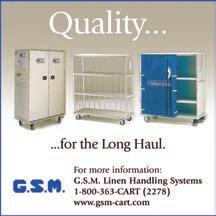
























































www.AmericanLaundryNews.com AMERICAN LAUNDRY NEWS | NOVEMBER 2018 27 Source Directory A convenient guide to sources of products and services APPAREL FINISHING CARTS, TRUCKS & BASKETS Source Directory listings in American Laundry News are sold on an annual basis at the following rates: All Major Credit Cards Accepted 2018 Listings Regular Boldface All Caps Four Line Listing per Year $900 $1,130 $1,130 Display and additional line rates available upon request CARTS, TRUCKS & BASKETS CARTS, TRUCKS & BASKETS ● Folder Stackers ● Tunnel Finishers ● Cart Washers ● Executive Pressing ● ● ● ● ph: 704.483.9316 sales@leonardautomatics.com http://leonardautomatics.com Financing Available • Laundry/Bushel Trucks • Exchange/Flare/Security Carts • Spring Lifts Diversified Plastics, Inc. South Carolina & Georgia • 800.768.7636 sales@dpirotocarts.com • dpirotocarts.com On-Time Delivery & Quality Service! BEST LAUNDRY TRUCKS & CARTS BEST LAUNDRY TRUCKS & CARTS M c C LURE INDUSTRIES, INC. 800-752-2821 • www.mcclureindustries.com email: kim@mcclureindustries.com Sani-Trux is the only molded cart to pass rigorous independent laboratory testing for NFPA fire codes Made of durable fiberglass making the cart life at least twice that of a poly cart Easy to maneuver even in tight spaces Built with quality components to last years longer than other carts Visit our website for other models and avaliable options. We sell direct to all parties! M.I.T. POLY-CART 211 CENTRAL PARK WEST, NEW YORK, NY 10024 800-234-7659, FAX: 212-721-9022 WWW.MITPOLYCART.COM l-800-275-2436 l-800-275-2436 maxi-movers.com Email:sales@maxi-movers.com in 14 sizes up to 84 cu. ft. capacities. Ask about our removable, adjustable hanger bars for Bulk Trucks! M7090 Easy loading front cut out and locking security covers 3 6 6 o m m M7070, 1 ft. shorter allows more visibility Rugged, non-marring trucks M BULK DELIVERY TRUCKS Meese is formerly MODRoto IT TAKES A TOUGH RIDE TO HAUL YOUR DELICATES. The Meese 72P is the original and the industry standard. When your set of wheels is a 72P, you’ll be rolling together for years to come. Call 800-829-4535 www.meese-inc.com customerservice@meese-inc.com 800.304.4600 www.FIBERTECHINC.net $268 $239 Regrind Material Virgin Material Get the info you need online... www.AmericanLaundryNews.com



























28 NOVEMBER 2018 | AMERICAN LAUNDRY NEWS www.AmericanLaundryNews.com Source Directory A convenient guide to sources of products and services FLATWORK IRONERS Knowhow In Action Your Tingue rep is a fully trained master of finishing equipment operation, maintenance and installation. Call for: • Pads, covers, belts, waxes, tapes and more • Carts, trucks, baskets and bags • Parts, rebuilds and repairs 800.829.3864 www.Tingue.com MODRoto.com TBR-Associates.com C & W EQUIPMENT (800) 443-3573 FLATWORK IRONER SPECIALISTS REMANUFACTURED IRONERS: Super Sylon Sylon Hypro’s Super Pro Jensen SS700 SS800 Ultima Lavatec UPGRADE KITS: Chain Drive Conversion Vacuum Systems Herringbone Conversion Canopies Inverters Side Covers Roll Springs Jensen Drives SUPPLIES: Aprons Pads Covers Belts Waxes Cleaners PARTS/REPAIRS: All Brands New/Refurbished/Hard to Find COMMITTED TO EXCELLENCE Pellerin Milnor Corp. P.O. Box 400, Kenner, LA 70063 504-467-9591, Fax: 504-468-3094 www.milnor.com DRYERS – 100 POUNDS OR MORE Pellerin Milnor Corp. P.O. Box 400, Kenner, LA 70063 504-467-9591, Fax: 504-468-3094 www.milnor.com CLEAN CYCLE SYSTEMS 960 Crossroads Blvd., Seguin, TX, 78155 800-826-1245 • CCsystems@tqind.com www.cleancyclesystems.com DRYERS – 100 POUNDS OR LESS LINT COLLECTORS & FILTERS MAT ROLLERS DRYER BOOSTER & EXHAUST FANS Gardner Machinery Corporation P.O. Box 33818, Charlotte, NC 28233 Ph.: (704)372-3890; Fax: (704)342-0758 www.gardnermachinery.com MATERIAL HANDLING / CONVEYORS www.energenics.com ENERGENICS CORPORATION TALK TO OUR DESIGN AND ENGINEERING STAFF ABOUT YOUR NEEDS 1470 Don St. • Naples, FL 34104 • 800-944-1711 ›› Our In-Line Lint Filter mounts inside, saves space! ›› OPL Duct Mounted Lint Filters 1,000 to 2,700 CFM ›› Fiberglass or Stainless Steel Dry Filters ›› Hundreds Sold Annually Source Directory listings in American Laundry News are sold on an annual basis at the following rates: All Major Credit Cards Accepted 2018 Listings Regular Boldface All Caps Four Line Listing per Year $900 $1,130 $1,130 Display and additional line rates available upon request HEALTH CARE LINEN TRANSPORT CARTS “In-House” or “Over-The-Road Transport” Ergonomic Aluminum - Tough Fiberglass – Ultimate Stainless ALL SIZES & CUSTOM C APABILITIES 800-826-1245 | www.tqind.com | TQcarts@TQind.com America’s #1 Trusted Source Since 1961! HEALTHCARE LINEN TRANSPORTS www.energenics.com ENERGENICS KARTWASHERS FULLY AUTOMATIC KARTWASHER PREMIER W/TOUCHPAD 1470 Don St. • Naples, FL 34104 • 800-944-1711 Designed to wash and sanitize all popular laundry carts • Automatic two minute cycle • Dries and sanitizes • Minimum water useage Concentrates wash effectiveness on the cart interior Fast automatic washing, sanitizing and drying insure optimum cleaning • 15 second detergent wash and sanitizing rinse cycle • Adjustable automotive car wash style drying 1116aln_Energenics Cart Washers SD.indd 1 9/27/16 3:30 PM OPL-Series DLF-500 Lint Lasso 1,000-10,000 CFM Established: 1991 4,000-35,000 CFM Established: 1985 4” to 18” Duct Established: 2011 www.cleancyclesystems.com • 800 . 992 . 0697 CART-WASHING SYSTEMS What Every Laundry Needs In A Cart Washer: M c C LURE INDUSTRIES, INC email: kim@mcclureindustries.com 800-752-2821 • www.mcclureindustries.com A cart washer that works continuously for 15-20 years. The ability to install your cart washer in a cross-contamination barrier wall. A cart washer that really, truly cleans each cart of bio-contaminents inside and out. One that uses existing utilities - no remodel costs. Time selectable efficient cycles that use a minimum amount of water.
Pellerin Milnor Corp. P.O. Box 400, Kenner, LA 70063 504-467-9591, Fax: 504-468-3094 www.milnor.com
Pellerin Milnor Corp. P.O. Box 400, Kenner, LA 70063 504-467-9591, Fax: 504-468-3094 www.milnor.com










Pellerin Milnor Corp.
P.O. Box 400, Kenner, LA 70063 504-467-9591, Fax: 504-468-3094 www.milnor.com
Pellerin Milnor Corp.


















P.O. Box 400, Kenner, LA 70063 504-467-9591, Fax: 504-468-3094 www.milnor.com



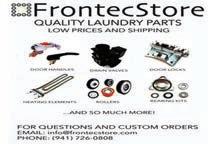
www.AmericanLaundryNews.com AMERICAN LAUNDRY NEWS | NOVEMBER 2018 29 Source Directory A convenient guide to sources of products and services PARTS PARTS & SUPPLIES CINCINNATI LAUNDRY EQUIPMENT We stock all the parts you need! We have something for everybody! Parts for All Major Manufacturers 2648 Spring Grove Avenue Cincinnati, OH 45214 Phone: 513-542-5000 • Fax: 513-542-5022 www.cincinnatilaundry.com cle@cincinnatilaundry.com Your #1 AJAX Source! AJAX • CISSELL LAVATEC • ALLIANCE IPSO • HUEBSCH JENSEN HYPRO/SUPER SYLON HOFFMAN • VOSS PERMAC
– 100 POUNDS OR LESS WASHER-EXTRACTOR – 100 POUNDS OR MORE
WASHERS – CONTINUOUS BATCH WASHER-EXTRACTOR
SMALL-PIECE FOLDERS
PRESSES – EXTRACTION CONTACT US TO BOOK YOUR AD TODAY! CLASSIFIEDS@ATMAGS COM TO PLACE YOUR AD CALL DON FEINSTEIN 312-361-1682 Source Directory listings in American Laundry News are sold on an annual basis at the following rates: All Major Credit Cards Accepted 2018 Listings Regular Boldface All Caps Four Line Listing per Year $900 $1,130 $1,130 Display and additional line rates available upon request Company Page Company Page INDEX OF ADVERTISERS A.L. Wilson Chemical Co. 9 ADI American Dawn 5, 17 AquaRecycle 8 Clean Show ...............................................................................................13 Consolidated Laundry Machinery 15 Direct Machinery Sales Corp. 26 EDRO Corp. 25 GA Braun 21 Girbau Industrial 7 The Griffin Group Inc. .............................................................................26 Jensen 20 J.P. Equipment 26 Kannegiesser ETECH 19 Kemco Systems Inc. 24 LaundryCareers.com 26 Lavatec Laundry Technology 32 Maytag Commercial Laundry 22-23 McClure Industries 20 Norchem Corp. .........................................................................................11 PSP Industrial 26 Pellerin Milnor 3 Royal Basket Trucks 10 Stanco Industries 26 TRSA 18 Venus Group 31 Washburn Machinery 26 MICROFIBER Durable Micro ber Cloths www.texasmicro ber.com 214-810-9563/800-742-2913 ///////////////////////////////////////////////////////////////////////////////////////////// (844) 447-5559 // www.maxi-press.us PRESS MEMBRANES LAUNDRY SPARE PARTS
Journal publishes LCA on reusable
isolation
gowns
MISSION, Kan. —For the first time in history, an esteemed, peer-reviewed journal has published research that confirms the sustainability benefits reusable isolation gowns, according to the American Reusable Textile Association (ARTA).
ARTA, in conjunction with the International Association for Healthcare Management (IAHTM) and other ARTA members, funded the research comparing the life cycles of reusable versus disposable isolation gowns.
This LCA has now been peer-reviewed and published in the August issue of the American Journal of Infection Control The study was conducted by Environmental Clarity Inc. of Reston, Va.
Peer-review is an intensive process that confirms the credibility of research and provides a scientific, irrefutable record that documents the sustainability benefit of reusable isolation gowns, states ARTA.
“Our life-cycle analysis (LCA) proves that reusable isolation gowns are the responsible choice for healthcare clients who care about reducing energy costs, carbon footprint, as well as purchasing and waste disposal costs,” says ARTA President Brendan O’Neill of London Hospital Linen Service Inc. in London, Ontario.
Disposable and reusable isolation gowns were studied from their inception as raw materials in the earth to manufacture of the coverall product, to use/reuse, then to final end-of-life disposition. The scope and the results emphasize transparent, science-based life cycle analysis. An abstract on the study is available at www.ARTA1.com
The study found that choosing reusable isolation gowns instead of disposable alternatives decreases the environmental footprint by:
• 28% lower natural resource energy consumption.
• 30% lower greenhouse gas emissions (measured as CO2 eq emissions).
• 41% lower total water consumed (blue water1).
• 93-99% lower solid waste generation at healthcare facility.
End users can count these improvements as a credit toward improving their sustainability programs, ARTA says.
Armed with LCA data, the association says the next step is to identify ways to normalize the information and make the data part of a business case for converting a client from disposable to reusable systems.
To read the article in the American Journal of Infection Control, download a PDF from the organization’s website: www.ajicjournal.org/issue/S0196-6553(17)X0009-6.
Encompass Group VP honored by Department of Veterans Affairs

MCDONOUGH, Ga. — Ken Tyler, vice president-government operations for Encompass Group LLC, a manufacturer and marketer of reusable textiles, professional apparel, and disposable and single-use medical products, has been awarded the Veterans Affairs 2018 Lifetime Achievement Award, the company reports.
“We are pleased to announce this recognition of Ken’s lifetime of dedication to the care of our nation’s veterans,” says John Wood, CEO of Encompass. “He is an integral part of Encompass Group’s government operations. Ken has served his country for most of his life. Prior to joining us, he served at the Department of Veterans Affairs, the Department of the Navy, and is a decorated U.S. Marine Corps combat veteran.”
The award was presented in August during the VA National Environmental Programs Service Conference held in Orlando.
“I am very honored to be recognized by the VA with this award,” Tyler says. “It has been an honor to aid our country’s veterans and to serve our nation.”
The Lifetime Achievement Award was presented, “In
recognition of Ken Tyler’s superb leadership and professionalism resulting in far-reaching improvements in the effectiveness and quality of healthcare delivery to veterans nationwide.”
Tyler served as chief, textile care division, at VA Headquarters, Washington, D.C., from 1977 to 2000. He is best known for his development of the VA Laundry Modernization Program, where he managed the modernization of 54 facilities (valued at $175 million) and the construction of 15 new VA laundries (valued at $140 million). He was very active in management of the VA Laundry Consolidation Program in which VA consolidated 73 existing facilities into just 41.
Encompass says that some of Tyler’s most notable accomplishments include managing the EMS product standardization program and uniform committee, serving as acting EPS director from 1989-1991, and his development of the Under Secretary for Health Field Laundry Advisory and establishment of the VA laundry/quality assurance programs.
Additionally, he is a graduate of the VA Leadership Program and a recipient of three Hammer Awards from the vice president of the United States, three Scissor Awards from the Secretary of Veterans Affairs, and two Department of Energy Conservation Awards.
“There’s no better exemplar of our commitment to helping our customers deliver better care than Ken Tyler,” Wood says. “We are so proud of him and his service.”
In memoriam: Bernard S. Speckhart, White Conveyors
KENILWORTH, N.J. — Bernard S. Speckhart, chairman
and CEO of White Conveyors, passed away Sept. 9, the company reports.

Speckhart was a true leader and innovative inventor in garment and linen material-handling solutions, the company says. His patented conveyor designs revolutionized the industry. Under his direction, more than 100,000 conveyors have been installed in the United States and throughout the world.
“The loss of our beloved father and company leader is profound,” says Mary Speckhart, his daughter and president of White Conveyors and Speed Check. “He will be remembered by the many who loved him as a kind and generous man who cared deeply for his family. My father was dedicated to the success of White, as well as to each and every member of our extended White family.
“Bernie’s vision, leadership and generosity will be missed immensely, but his legacy will live on for many generations to come.”
In 1949, Speckhart graduated with a Bachelor of Science in mechanical engineering from Newark College of Engineering (now New Jersey Institute of Technology) located in Newark, N.J. He joined White Machine Co. in 1954 under the tutelage of his father, Stephen Speckhart, after having served in the U.S. Air Force during the Korean War.
From the very beginning, the company says Speckhart’s vision was to design cutting-edge conveyor systems to help companies increase production and save labor. In 1984, White Machine established White Conveyors, and full ownership was transferred to him from his father.
In 2008, under his leadership, White acquired Speed Check Conveyor, located in Decatur, Ga., and strengthened the commercial and industrial laundry divisions of the company. Speckhart spent a total of 64 years at the family business.
In addition to his esteemed professional career, he was a devout member of the Catholic church, served the Boy Scouts of America, and actively volunteered in the community.
A true family man, Speckhart is survived by his beloved wife, M. Lorraine Speckhart, seven devoted children, 22 grandchildren, two great grandchildren, and a large and loving extended family. Several of his children hold key positions at the company. Mary was named president of White and Speed Check in 2014. His sons, B. Stephen and John, currently serve as vice presidents. ALN
Career Track
Auger joined RD Industries in June 2017 as the vice president of international sales. In his short time with RD Industries, the company says Auger, and his teams, have expanded the global sales footprint along with driving customer satisfaction, and he has served as a trusted advisor to the management team.
During a 10-year career at Nordson EFD, Auger held numerous sales, operations and leadership positions from the European headquarters in the United Kingdom.
His 25 years of experience span across a variety of roles in finance, sales, project management and customer service, where he innovated new go-to market strategies focused on new customer acquisition and customer excellence, says the company.
Gurtler hires N.Y., Eastern Pa. manager of market development

SOUTH HOLLAND, Ill. — Gurtler Industries Inc., a manu-
facturer of advanced detergents and specialty chemicals for the commercial laundry industry, says it hired Thomas Baudendistel in August.
Baudendistel will be manager of market development in upstate New York and eastern Pennsylvania. The company says he brings four-plus years of experience in the laundry industry.
30 NOVEMBER 2018 | AMERICAN LAUNDRY NEWS www.AmericanLaundryNews.com
Ken Tyler (center), VP government operations, Encompass Group LLC, receives the Department of Veterans Affairs 2018 Lifetime Achievement Award from Tammy Czarnecki (left), Deputy Under Secretary for HealthVA, and Aubrey Weekes (right), Director Environmental Programs OfficeVA. (Photo: Encompass Group LLC)
Speckhart
ALN
Baudendistel
Continued from Page 25

800.421.6599 Call us today for more information Cotton-Rich Luxury Sheets Lasts 200 Commercial Washings Patented Technology Available in Solid White or Tone on Tone 10mm Stripe LUXURY SHEETS THAT LAST VenusGroup.com/performance Performance Twill with INVICTUS TECHNOLOGY® ® Available in Solid or Stripe Discover Venus | INSTITUTION Yes, We Do That Too!




































































































































































































































































